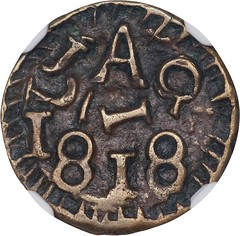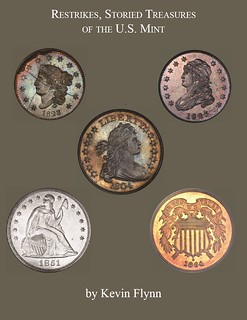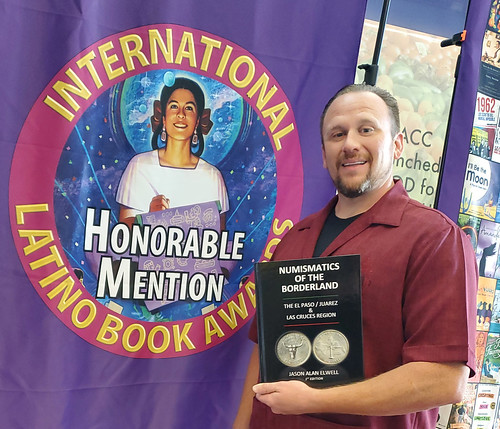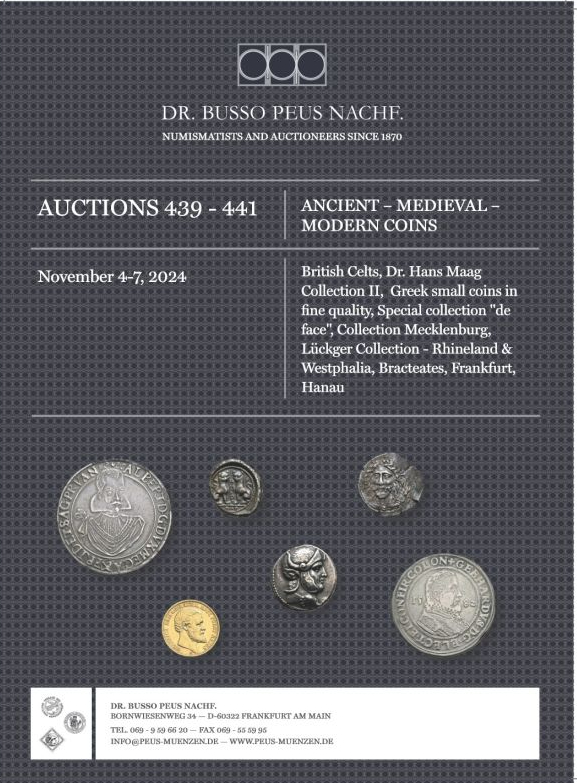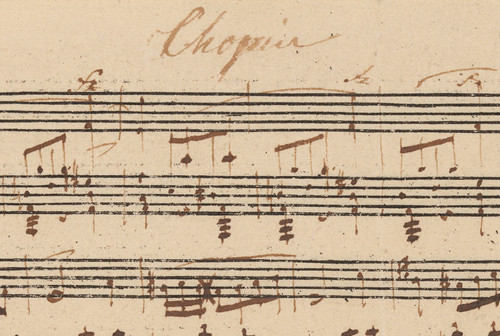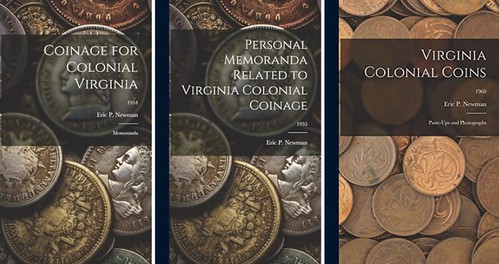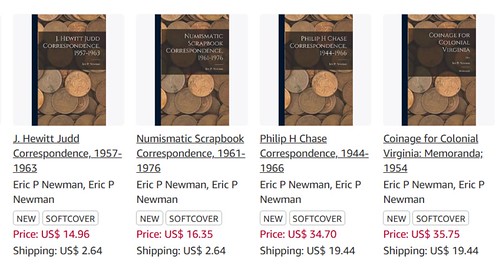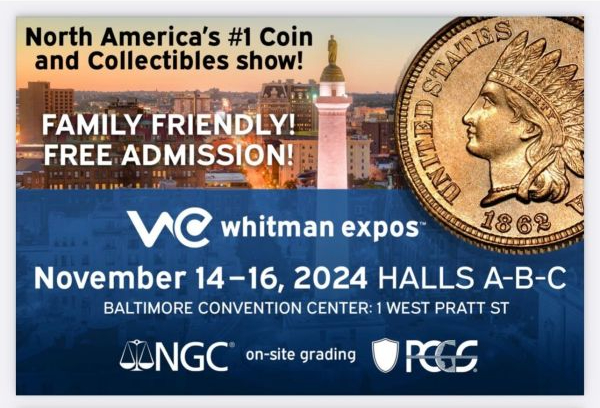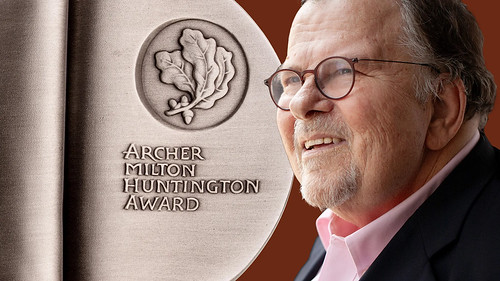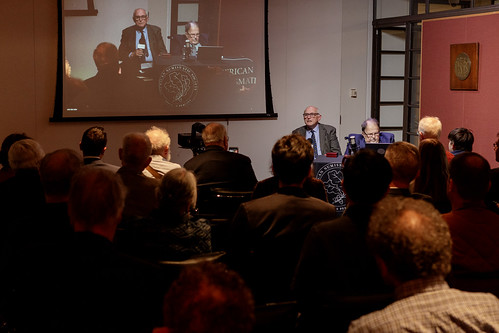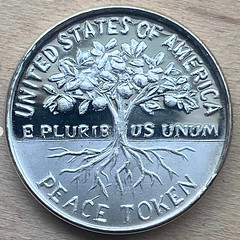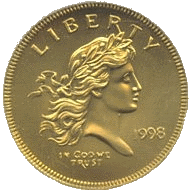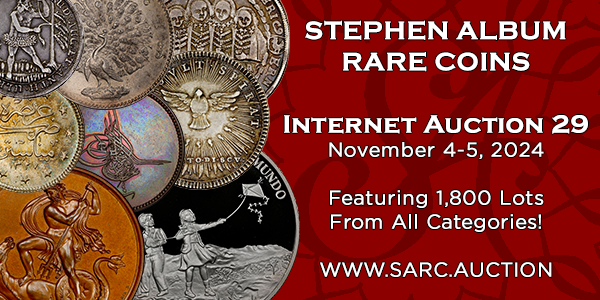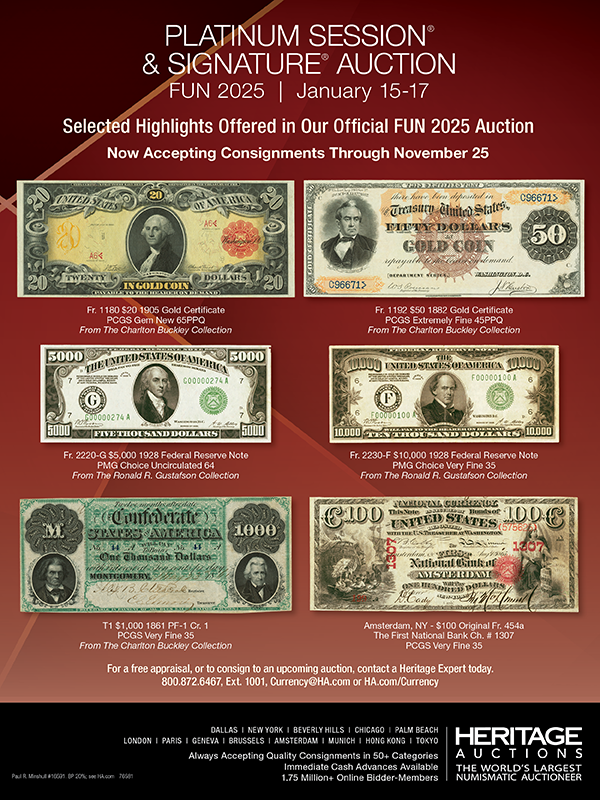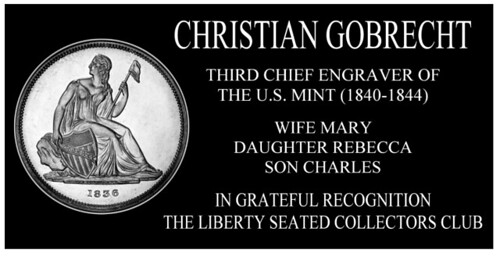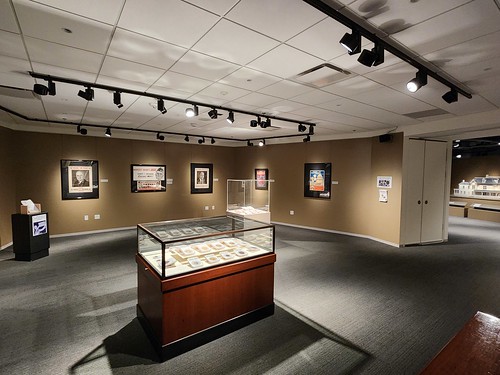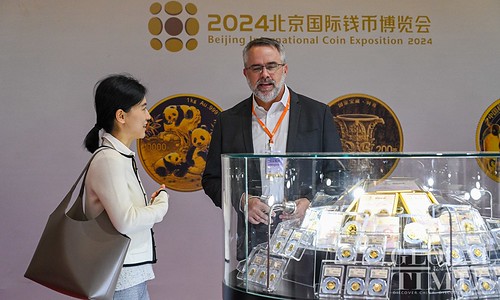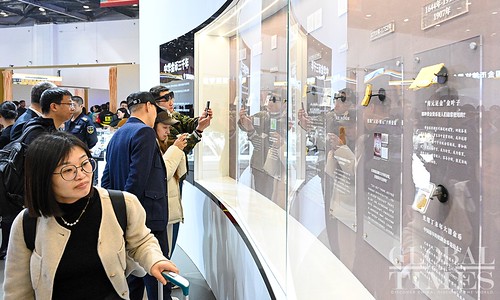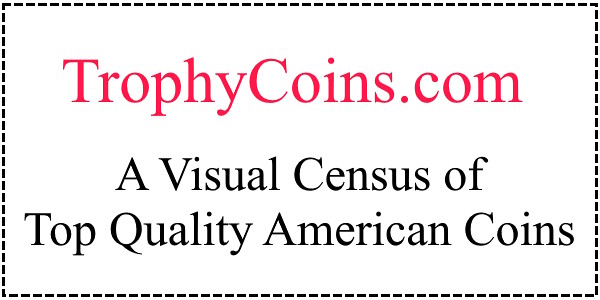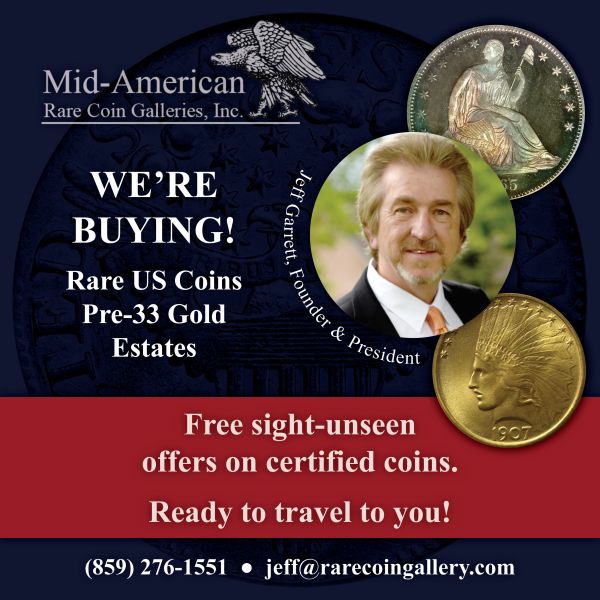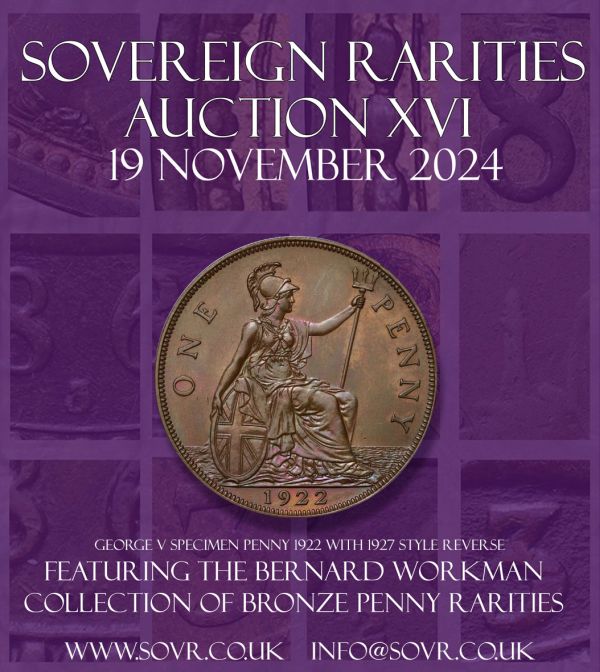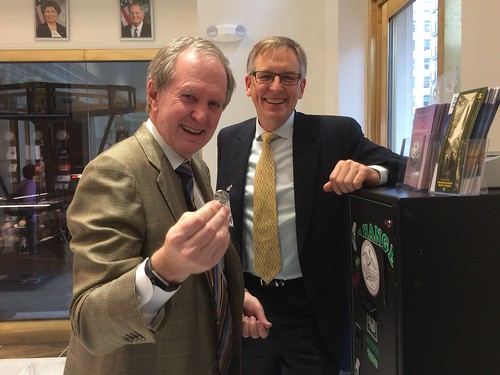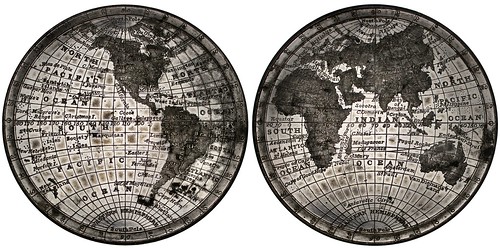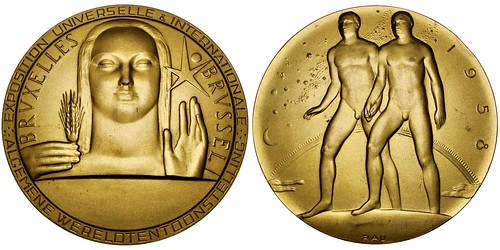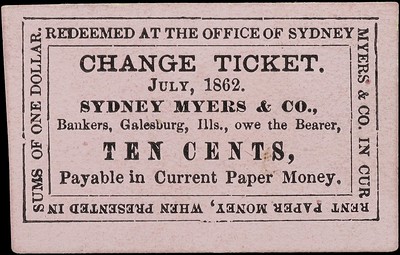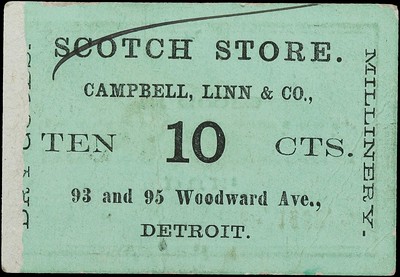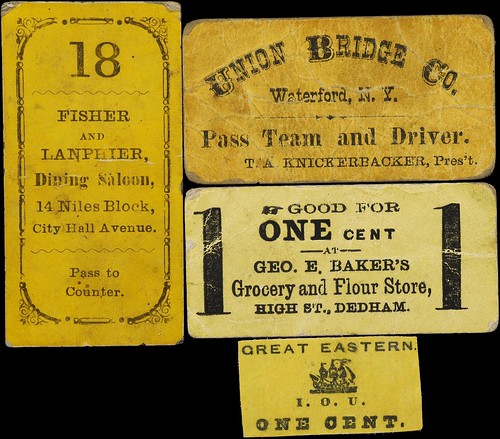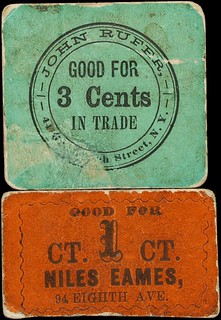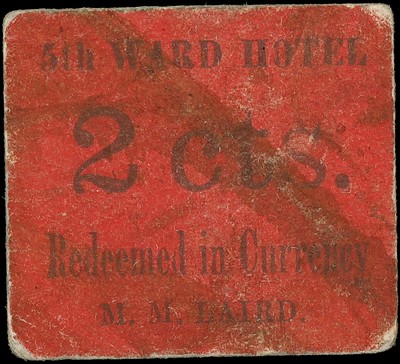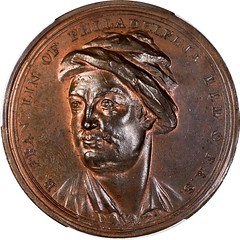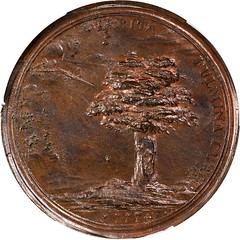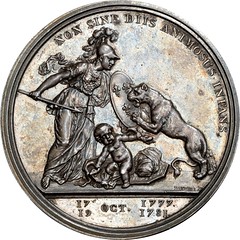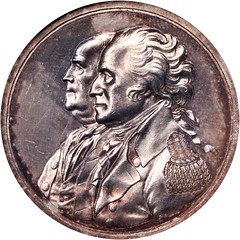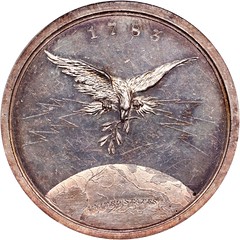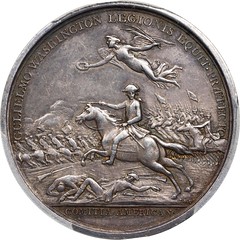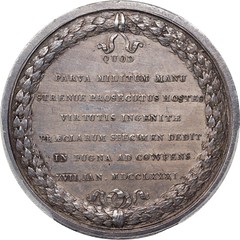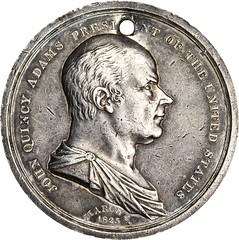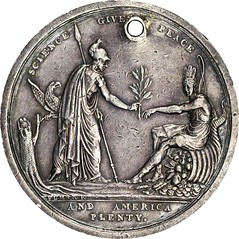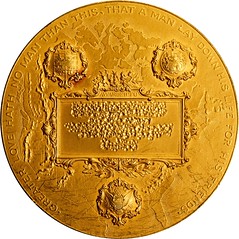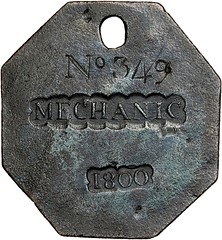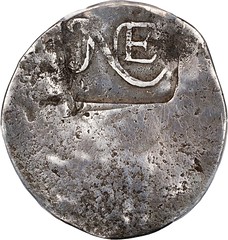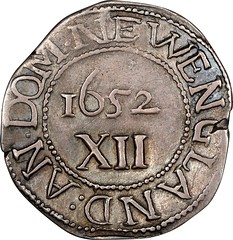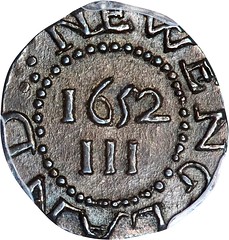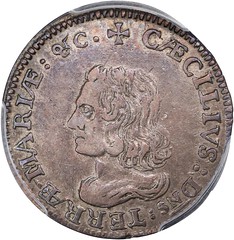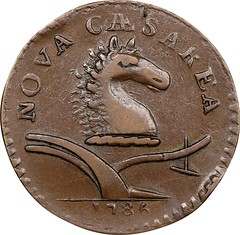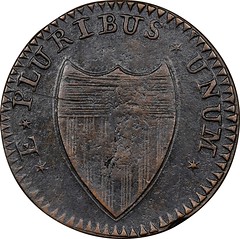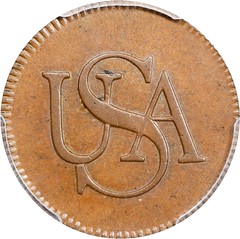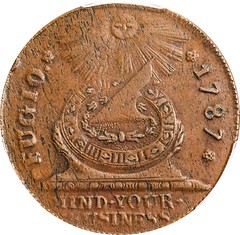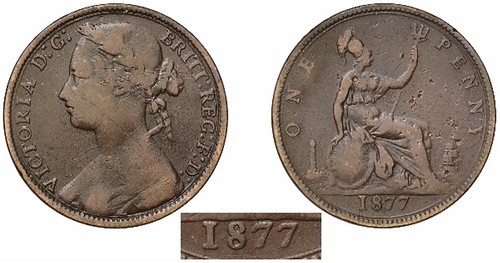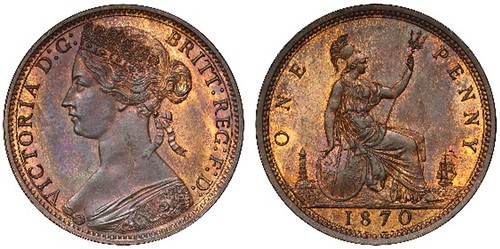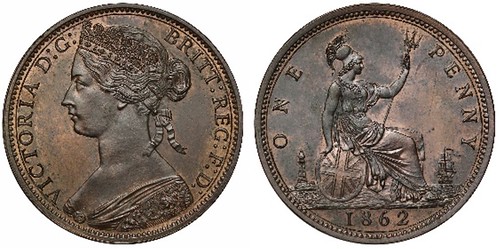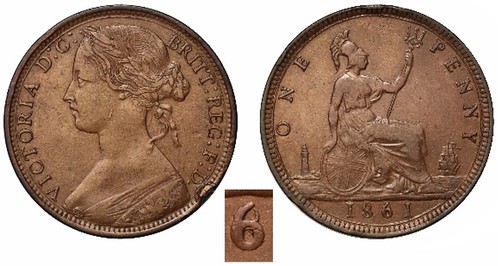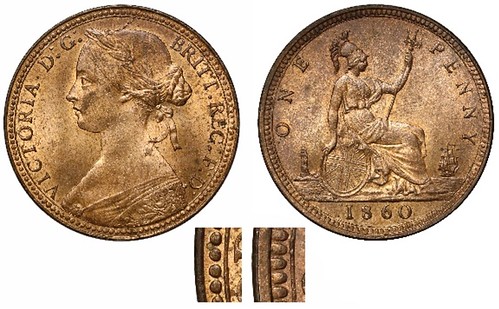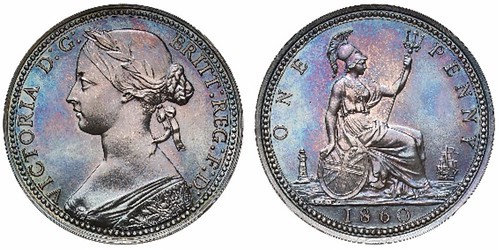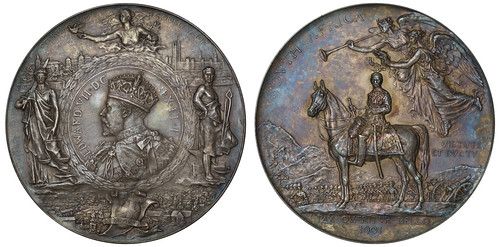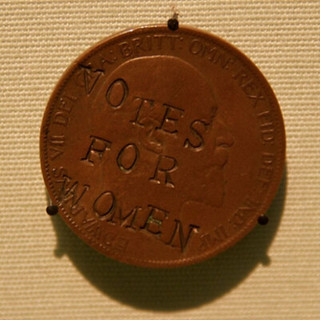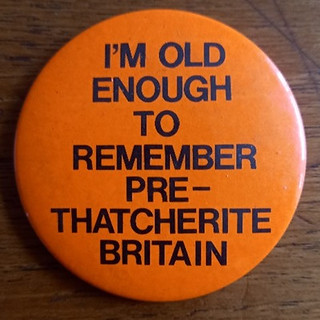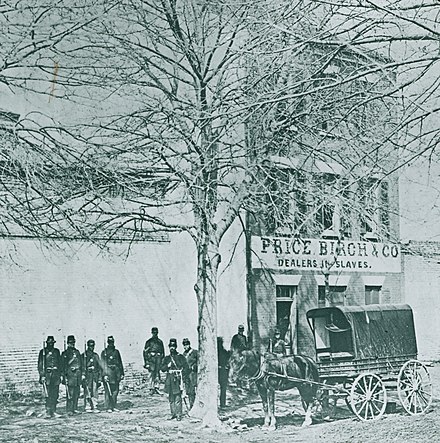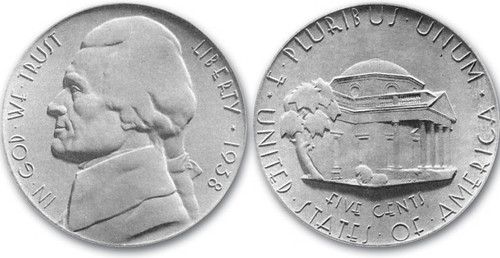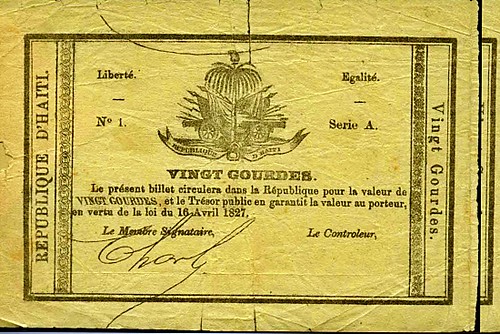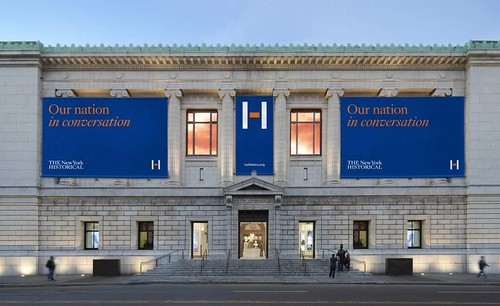
Visit our NBS Sponsors
About UsThe Numismatic Bibliomania Society is a non-profit association devoted to the study and enjoyment of numismatic literature. For more information please see our web site at coinbooks.org SubscriptionsThose wishing to become new E-Sylum subscribers (or wishing to Unsubscribe) can go to the following web page link MembershipThere is a membership application available on the web site Membership Application To join, print the application and return it with your check to the address printed on the application. Print/Digital membership is $40 to addresses in the U.S., and $60 elsewhere. A digital-only membership is available for $25. For those without web access, write to: Jeff Dickerson, Treasurer AsylumFor Asylum mailing address changes and other membership questions, contact Jeff at this email address: treasurer@coinbooks.org SubmissionsTo submit items for publication in The E-Sylum, write to the Editor at this address: whomren@gmail.com BUY THE BOOK BEFORE THE COINSale Calendar
|
- WAYNE'S WORDS: THE E-SYLUM NOVEMBER 3, 2024
- NEW BOOK: RESTRIKES
- NEW BOOK: COINS OF EASTERN MOUNT OSSA
- NEW BOOK: GUIDE FOR COIN COLLECTORS 2.0
- NUMISMATICS OF THE BORDERLAND WINS AWARD
- A RARE NEW JERSEY COLONIAL NOTE
- VIDEO: COLLECTING ERROR COINS
- AN EXPLOSION OF NUMISMATIC BOOKS
- ANA RECOGNIZES NJNS 90-YEAR MEMBERSHIP
- 2024 ANS ARCHER M. HUNTINGTON AWARD
- 2025 ANS GALA ANNOUNCED
- THE PEACE 2000 COIN PROGRAM
- THE PEACE 2000 COIN PROGRAM PROPOSAL
- NOTES FROM E-SYLUM READERS: NOVEMBER 3, 2024
- TRUMAN LIBRARY INAUGURAL MEDAL EXHIBIT
- 2024 BEIJING INTERNATIONAL COIN EXPO
- VOCABULARY TERM: PROOF FINISH, PART 2
- WILLIAM CHARLES HIBBERT, SR. (1909-1968)
- KELLEN HOARD INTERVIEW, PART FOUR
- KENTUCKY COLONEL MICHAEL MORAN
- NUMISMAGRAM MEDAL SELECTIONS: NOVEMBER 3, 2024
- RICHARD ROSSA CARDBOARD SCRIP
- SBG NOVEMBER 2024 NUMISMATIC AMERICANA
- SOVEREIGN RARITIES WORKMAN COLLECTION, PART 3
- THE SOUTH AFRICA PEACE MEDAL
- MEDIEVAL RHENISH GUILDER FOUND IN POLAND
- ELECTIONS AND VOTING IN NUMISMATICS
- WSJ ON BANKNOTE COLLECTING
- BANKING ON SLAVERY
- LOOSE CHANGE: NOVEMBER 3, 2024
Content presented in The E-Sylum is not necessarily researched or independently fact-checked, and views expressed do not necessarily represent those of the Numismatic Bibliomania Society.
WAYNE'S WORDS: THE E-SYLUM NOVEMBER 3, 2024
 New subscribers this week include:
Anne Hooker of the Monticello Coin Club, courtesy Chip Howell.
Welcome aboard! We now have 7,264 subscribers.
New subscribers this week include:
Anne Hooker of the Monticello Coin Club, courtesy Chip Howell.
Welcome aboard! We now have 7,264 subscribers.
Thank you for reading The E-Sylum. If you enjoy it, please send me the email addresses of friends you think may enjoy it as well and I'll send them a subscription. Contact me at whomren@gmail.com anytime regarding your subscription, or questions, comments or suggestions about our content.
This week we open with three new books, a book award, updates from the Newman Numismatic Portal, ANA, and ANS, notes from readers, and more.
Other topics this week include restrikes of the U.S. Mint, error coins, the New Jersey Numismatic Society, the Peace 2000 coin program, inaugural medals, the Beijing International Coin Expo, cardboard scrip, auction previews, the South Africa peace medal, and the money backing slavery.
To learn more about Numismatics of the Borderland, Ernest Keusch, Assay Commission medals, proof finishes, the Amateur Coin Collectors Club, the Citizens Coinage Advisory Committee, the Althea Gibson American Women's quarter, Michael Moran, the Lord Baltimore Sixpence, the Bar Copper, the Haitian Gourde, and the effects of pestering, read on. Have a great week, everyone!
Wayne Homren
Editor, The E-Sylum
NEW BOOK: RESTRIKES
Kevin Flynn has published a new book on restrikes made at the U.S. Mint. Great topic - I don't think this has been explored before in a single work. Here's the announcement. -Editor
Restrikes, Storied Treasures of the U.S. Mint
by Kevin Flynn
Restrikes, Storied Treasures of the U.S. Mint by Kevin Flynn is currently at the printers. This book is being self-published, with only a limited number printed. The book is 8 1/2 by 11, 466 pages. Softcover Retail $75.00.
Restrikes were struck from the early 1830s through 1885. In the context of coins and numismatics, "restrike" normally implies and is defined as a coin that is struck not in the date which is stamped on the coin. The normal exception to this rule is in the early 19th century when it was an acceptable Mint practice to use working dies dated from the previous year in the beginning of the current year. For example, 1803 dated dollars were struck in the first quarter of 1804. Die steel was scarce and production of new working dies slow. In addition, the Mint more than likely did not want to waste unused working dies at the end of the year. Another normal exception is reverse working dies that were carried forward over several years and used to strike coins. As these reverses were undated, they could normally be used in subsequent years if they were not worn.
Even though our knowledge of restrikes was greatly expanded, there were also many unanswered questions such as: Why were restrikes created before 1859 and after 1870 and who was responsible for their creation? Were restrikes made outside the Mint? Who controlled the working dies during different periods? Were restrikes created for different reasons during the 19th century? These and many more questions drove the research and objective of this book.
Restrikes are one of the most intriguing and greatest mysteries of the U.S. Mint. The goal is to understand as much as possible from all the restrikes to be able to draw reasonable conclusions about this fascinating topic. Curiosity is one of the greatest traits for mankind, it pushes us to learn more and expand our knowledge. Hopefully this research will open doors on this topic, but also create interest for others to want to explore and learn more.
This book contains an immense amount of research, such as important Mint records from the National Archives; relevant coinage acts and statutes; related parts of Mint Reports, letters from Matthew Stickney, who obtained many of these restrikes directly from the Mint including an 1804 Type I Dollar; notes from Joseph Mickley's journal; private letters and applicable articles; George Eckfeldt's notebook; auction sales of restrikes. This information is listed in the appendix section and in the applicable restrike sections.
Each restrike is covered in great detail with photographs, description, analysis, history, and origins. Many photographs are presented, especially when there is a sequence in die states. Also covered are those varieties that were called restrikes that were refuted.
Price for the softcover is $75.00 plus $5 for media shipping or $10 for first class shipping. To order, send a check or money order to Kevin Flynn, P.O. Box 1043, Troy, VA 22974. Venmo is also accepted, please write first to kevinjflynn88@yahoo.com.
NEW BOOK: COINS OF EASTERN MOUNT OSSA
The American Numismatic Society has published a new book in their Numismatic Notes and Monographs series. Here's the announcement. -Editor
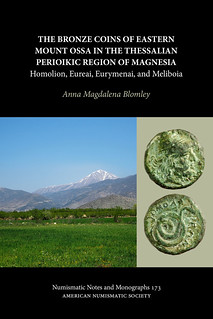 The Bronze Coins of Eastern Mount Ossa in the Thessalian Perioikic Region of Magnesia
?Homolion, Eureai, Eurymenai, and Melioboia?
The Bronze Coins of Eastern Mount Ossa in the Thessalian Perioikic Region of Magnesia
?Homolion, Eureai, Eurymenai, and Melioboia?
(Numismatic Notes and Monographs 173)
by Anna Magdalena Blomley
This monograph examines the Late Classical and Hellenistic bronze coinages of five mints in the Thessalian perioikic region of Magnesia. At the core of this work lies a new die-study of the coins produced by the strategically and economically important coastal cities of Homolion and Meliboia as well as the lesser-known mints of Eureai, Eurymenai, and Rhizous. Combining this die-study with a close examination of the cities' topographical context in a border region between Thessaly and Macedon and drawing on archaeological data from Magnesia and beyond, the monograph addresses key questions concerning the chronology, denominations, and circulation patterns of the bronze issues minted on eastern Mount Ossa. This analysis not only throws new light on coin production in Late Classical and Hellenistic Magnesia, but also allows a discussion of the possible military and non-military functions of the region's different bronze issues.
For any questions about the book please contact publications@numismatics.org, though orders should be placed directly with ISD or Brepols.
$100 regular price in the U.S. ($70 with ANS member discount)
€100 regular price outside the U.S. (€70 with ANS member discount)
For the member discount code, please contact us at membership@numismatics.org or (212) 571-4470 ext. 117
To order in the U.S. from ISD, see:
The Bronze Coins of Eastern Mount Ossa in the Thessalian Perioikic Region of Magnesia
(https://www.isdistribution.com/BookDetail.aspx?aId=170854)
To order outside the U.S. from Brepols, see:
The Bronze Coins of Eastern Mount Ossa in the Thessalian Perioikic Region of Magnesia
(https://www.brepols.net/products/IS-9780897223959-1)
NEW BOOK: GUIDE FOR COIN COLLECTORS 2.0
A new edition of the Dutch catalog for beginning collectors has been published. -Editor
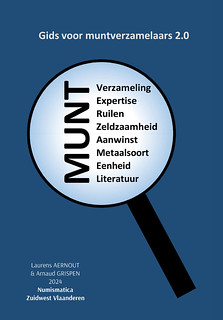 Gids voor Muntverzamelaars 2.0
Gids voor Muntverzamelaars 2.0
(Guide for Coin Collectors 2.0)
To promote numismatics and support coin collectors, the ‘Guide for Coin Collectors' has been thoroughly updated. This new edition, commissioned by Numismatica Zuidwest-Vlaanderen and compiled by Arnaud Grispen and Laurens Aernout, provides valuable knowledge and practical support for both novice and experienced collectors.
For everybody (e.g. metal detectorists, family members, ...) who are just starting to show an interest in numismatics, this guide serves as an accessible introduction. The aim is to inspire them to build a collection and to give them a better understanding of this fascinating hobby.
The Guide 2.0 includes the following chapters:
- How and what to collect?
- Coin quality and pricing
- Is coin collecting an expensive hobby or even an investment?
- Auctions and cooperation with professional dealers
- Most common metals and alloys
- Essential books and catalogs
- Tips for cleaning, storing, and securing coins
- Common numismatic terms and practical tips for group collecting
- Fun facts
This guide is specifically designed to help novice collectors find their way in the world of numismatics. We hope for the cooperation of everyone active in the numismatic field to support this project.
A total of 100 guides have already been distributed for free in Flanders, aimed specifically at (young) novice collectors.
The guide is A5 in size, has 80 pages, and is available for €7.50. It does not have an ISBN code.
For more information, or to order, see:
Gids voor muntverzamelaars 2.0
(https://www.zittergies.be/product/gids-voor-muntverzamelaars-2-0/)
Muntgids voor muntverzamelaars 2.0
(https://www.david-coin.com/product/muntgids-voor-muntverzamelaars-2-0/)
NUMISMATICS OF THE BORDERLAND WINS AWARD
Congratulations to El Paso numismatist Jason Alan Elwell, whose book Numismatics of the Borderland has been recognized by the International Latino Book Awards. The book covers medals, tokens, casino chips and more from the U.S.-Mexico border. -Garrett
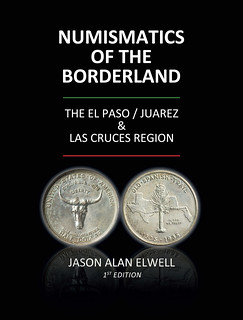 The borderland region of El Paso, TX, and Juarez, Mexico has a new reason to celebrate! Local El Paso numismatist (and author) Jason Alan Elwell received an Honorable Mention for his book Numismatics of the Borderland: The El Paso / Juarez & Las Cruces Region 1st Edition in the category of Best Reference Book 2024. This award was given by the International Latino Book Awards, the largest award in the USA celebrating achievements in Latino literature. The (ILBA) is hosted by Empowering Latino Futures, a Non-Profit 501(C)3 out of Los Angeles, CA.
The borderland region of El Paso, TX, and Juarez, Mexico has a new reason to celebrate! Local El Paso numismatist (and author) Jason Alan Elwell received an Honorable Mention for his book Numismatics of the Borderland: The El Paso / Juarez & Las Cruces Region 1st Edition in the category of Best Reference Book 2024. This award was given by the International Latino Book Awards, the largest award in the USA celebrating achievements in Latino literature. The (ILBA) is hosted by Empowering Latino Futures, a Non-Profit 501(C)3 out of Los Angeles, CA.
For the 2024 book competition, the (ILBA) had 239 judges review 6,000 books totaling 235,000 pages of literature. As each author and book competed for their respective category, only a fraction of submissions were selected to receive an award. The 2024 (ILBA) award ceremony was held on October 19, 2024, at the Los Angeles City College located in East Hollywood. At the ceremony, Jason Elwell accepted his Honorable Mention and could be seen sharing his thoughts about what makes borderland numismatics so special.
In writing this book, the author felt that numismatic literature was missing the connectivity that makes borderland numismatics so interesting. As the El Paso region borders (3) states (Texas, New Mexico, and Chihuahua) and (2) countries (United States and Mexico), it can be a challenge to research an item from this area. Most numismatic reference material tends to split up this region through standard cataloging efforts. By thinking outside the box and cataloging borderland numismatics (medals, tokens, wood nickels, casino chips, and more) alongside maps, historical photos, and documents within one book, it is hopeful that the reader will have a better understanding and appreciation for borderland culture and the numismatic items that have stood the test of time.
Numismatics of the Borderland: The El Paso / Juarez & Las Cruces Region 1st Edition features the most comprehensive catalog of borderland numismatics covering medals, tokens, casino chips, coins, scrip, and more! It showcases unknown and unlisted discoveries and actual size examples in high resolution and full color. This book is packed with specifications, descriptions, and over 950 images within its 218-page hardback format! While the meat and potatoes of this 1st edition are about El Paso, several items easily cross reference into Juarez and Las Cruces. This book was locally written and self-published by El Paso numismatist Jason Alan Elwell. Keep an eye out as this book is up for another literary award!
To order a book, please send a check for $74.95 (free Priority shipping in the U.S.) payable to: Almost AU Coins, 3262 Mansour Farah St, El Paso, TX 79938. International shipping varies.
To read the earlier E-Sylum article, see:
NEW BOOK: NUMISMATICS OF THE BORDERLAND
(https://www.coinbooks.org/v26/esylum_v26n43a07.html)
A RARE NEW JERSEY COLONIAL NOTE
Newman Numismatic Portal Project Coordinator Len Augsburger provided the following report on a very rare colonial note. Nice find. -Editor
A Rare New Jersey Colonial Note
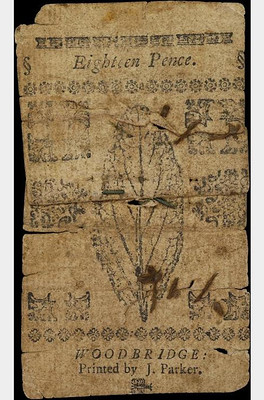 Certain numismatic items fall into the class of "very hard to find, but not necessarily expensive when you do." A recent example is a New Jersey January 26, 1756 18-pence note, offered by Stack's Bowers as lot 97006 in their October 24, 2024 Collector's Choice Online Auction. The Stack's Bowers catalog indicated "No. 4083. Plate A. Third War Issue. The earliest dated New Jersey 18d of all known pieces.
Certain numismatic items fall into the class of "very hard to find, but not necessarily expensive when you do." A recent example is a New Jersey January 26, 1756 18-pence note, offered by Stack's Bowers as lot 97006 in their October 24, 2024 Collector's Choice Online Auction. The Stack's Bowers catalog indicated "No. 4083. Plate A. Third War Issue. The earliest dated New Jersey 18d of all known pieces.
This extremely rare piece is believed to be unique and features the signatures of Samuel Nevill, Joseph Yard, Joseph Hollinshead. Unrepresented in the collections of Boyd, Ford, Newman, Budde and other numismatic luminaries. Pinned and sewn to prolong circulation." This example realized $216.
The Newman inventory, entered by hand into a 1967 first edition copy of Early Paper Money of America, confirms its absence in the Newman collection. Indeed, the Heritage Auctions archive lists only three examples of any January 26, 1756 denomination, while Stack's Bowers lists four pieces, going back to sales of 2005. Most notes of these emissions were redeemed, leaving few examples for modern collectors.
Newman Portal acknowledges Ed Sarrafian for bringing this piece to our attention and for contributing related images.
Images: New Jersey January 26, 1756 18-pence note, courtesy of Stack's Bowers.
Link to NNP edition of Early Paper Money of America:
https://nnp.wustl.edu/library/imagecollection/513468
Link to Newman's 1967 colonial paper money collection inventory:
https://archive.org/details/earlypaperinventory1967epnarchives
VIDEO: COLLECTING ERROR COINS
The David Lisot Video Library on the Newman Numismatic Portal can be found at:
https://nnp.wustl.edu/library/multimediadetail/522852
We highlight one of his videos each week in The E-Sylum. Here's one from 2009 with Bill Cowburn speaking about error coins. -Editor
Learn about the mistakes that can happen to modern issues of coinage from veteran lecturer and collector William Cowburn. See examples of coins that have been broadstruck, double struck, clipped, struck on the wrong planchet, struck with misaligned dies and other ways to make the money amazingly interesting to collectors.
From the 2009 Central States Numismatic Society convention.
To watch the complete video, see:
Collecting Error Coins
(https://youtu.be/Wyk-wymv3fg)
AN EXPLOSION OF NUMISMATIC BOOKS
We love to alert readers to new numismatic books. And a new publication of a long-lost manuscript from a long-dead numismatic author would be a sensation, like the score of a Chopin waltz recently discovered in the Morgan library.
To read the complete article, see:
Hear a Chopin Waltz Unearthed After Nearly 200 Years
(https://www.nytimes.com/2024/10/27/arts/music/chopin-waltz-discovery.html)
A recent look at used book site AbeBooks.com turned up not one, but dozens of books attributed to Eric P. Newman, who passed in 2017 at the age of 106.
These likely don't exist physically, but would be printed on demand from online sources. This practice is nothing new, but now the "stock image" book covers seem to have AI-generated images. I suspect the number of available new and "used" copies of each are made up too, and that the various sellers like "californiabooks.com" don't exist either.
They don't seem to list the number of pages, physical size or other standard bibliographic details. It's deceptive marketing, although I'm curious about the quality of the product. At under $20 apiece for most softcovers, I've spent more on lunch, and there may be some value for some buyers who want a physical copy to mark up or put bookmarks in.
This latest batch-o-books stems from the ongoing effort by the Newman Numismatic Portal to digitize Eric's files. But it's not just Eric's work being "published" - these digital-to-physical books have been available for some time from countless authors dead and alive. Only the crappy AI-generated covers are new.
Newman Portal Project Coordinator Len Augsburger writes:
"For example, see entries on Abebooks related to National Archives material we have scanned: https://www.abebooks.com/servlet/SearchResults?cm_sp=SearchF-_-topnav-_-Results&kn=national%20archives%20record%20group%20104&sts=t
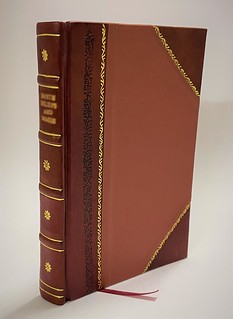 "These print-on-demand services absorb anything they can find in the public domain, including NNP resources. When NNP started I sent cease-and-desist notifications to a few of them, but it's a game of whack-a-mole against foreign operators.
"These print-on-demand services absorb anything they can find in the public domain, including NNP resources. When NNP started I sent cease-and-desist notifications to a few of them, but it's a game of whack-a-mole against foreign operators.
"I've actually purchased a few of these myself, when it was useful to have a hardcopy of something. I view it as an inexpensive print-on-demand adjunct to Internet Archive and other repositories such as HathiTrust."
To read the complete listings, see:
Coinage for Colonial Virginia: Memoranda; 1954
(https://www.abebooks.com/Coinage-Colonial-Virginia-Memoranda-1954-Hassell/32022081164/bd)
Personal Memoranda Related to Virginia Colonial Coinage; 1955
(https://www.abebooks.com/Personal-Memoranda-Related-Virginia-Colonial-Coinage/32022070785/bd)
Virginia Colonial Coins: Paste-ups and Photographs; 1960
(https://www.abebooks.com/servlet/BookDetailsPL?bi=31835326861)
Eric Newman, Hassell Street Press (37 results)
(https://www.abebooks.com/servlet/SearchResults?
an=Eric%20Newman&bi=0&bx=off&cm_sp=SearchF-_-Advs-_-Result&ds=
30&pn=Hassell%20Street%20Press&prc=USD&recentlyadded
=all&rgn=ww&rollup=on&sortby=17&xdesc=off&xpod=off)
ANA RECOGNIZES NJNS 90-YEAR MEMBERSHIP
Jeff Burke submitted this note on a recent milestone for the New Jersey Numismatic Society. Congratulations! -Editor
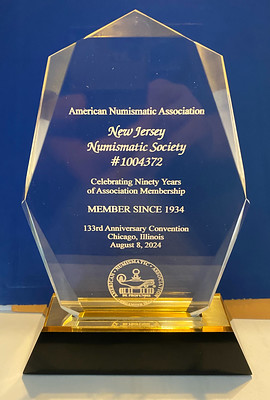 "The American Numismatic Association Recognizes the New Jersey Numismatic Society with 90-Year Club Award"
"The American Numismatic Association Recognizes the New Jersey Numismatic Society with 90-Year Club Award"
In August 2024, the American Numismatic Association recognized the New Jersey Numismatic Society (NJNS) for 90 years of continuous membership dating to 1934. The NJNS received a beautiful acrylic engraved plaque to mark this special occasion. In addition, the NJNS was listed in the 90-Year Clubs section of the "Membership Anniversaries" in The Numismatist, August 2024, p. 59.
At our October 2024 meeting, Ray Williams, NJNS Vice President, showed the in-person and online Society members the ANA award and explained how the plaque featured the engraving inside the acrylic.
The NJNS was founded in 1933 and joined the ANA in 1934.
Postscript: Focus on Ernest E. Keusch (1916-2000), Authority on U.S. Assay Commission Medals
Notable NJNS member Ernest Keusch started collecting coins in childhood and graduated from Princeton University in 1938. "He was especially drawn to offbeat collectibles, including assay medals, U.S. pattern coins, miniature Mint medals of the 1920s and '30s, sutler tokens and paper scrip. His personal collection of Assay Commission medals was one of the finest ever formed." (Ed Reiter, "New Jersey Numismatist ‘Ernie' Keusch Dies at 84," PCGS article, March 13, 2000).
Keusch was a life member of the American Numismatic Association. He also was a member of the American Numismatic Society, the Numismatic Literary Guild, the New Jersey Numismatic Society (NJNS) and the New York Numismatic Club. From 1982 to 1992, he served as a club officer in the NJNS. Ernest has the distinction of being the only NJNS member to receive the Charles F. Nettleship Award for Service to the NJNS twice, in 1985 and again in 2000 (Pour Merite).
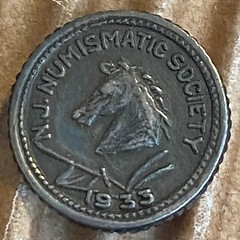 "Keusch not only possessed a broad range of numismatic knowledge, but also shared it freely, frequently assisting new collectors." (Reiter PCGS article). In a recent article, Edward Van Orden explained that Keusch's and Robert W. Julian's guide, "[t]he 1989 Token and Medal Society publication Medals of the United States Assay Commission 1860-1977, provides the basis of the classification system used for Assay Medals today. This definitive work includes 123 die combinations and attributes them by Julian Keusch Assay Commission numbers (JK-AC)." (Van Orden, "A Survey of Presidential Assay Commission Medals," PCGS article, October 2, 2024). Keusch was aided by his own collecting prowess, as he "amassed 141 medals across 96 dates[.]" (Van Orden PCGS article). In November 2008, Stack's conducted a sale of the Ernest E. Keusch Collection of United States Assay Medals, 1860-1977.
"Keusch not only possessed a broad range of numismatic knowledge, but also shared it freely, frequently assisting new collectors." (Reiter PCGS article). In a recent article, Edward Van Orden explained that Keusch's and Robert W. Julian's guide, "[t]he 1989 Token and Medal Society publication Medals of the United States Assay Commission 1860-1977, provides the basis of the classification system used for Assay Medals today. This definitive work includes 123 die combinations and attributes them by Julian Keusch Assay Commission numbers (JK-AC)." (Van Orden, "A Survey of Presidential Assay Commission Medals," PCGS article, October 2, 2024). Keusch was aided by his own collecting prowess, as he "amassed 141 medals across 96 dates[.]" (Van Orden PCGS article). In November 2008, Stack's conducted a sale of the Ernest E. Keusch Collection of United States Assay Medals, 1860-1977.
For more information about Ernest Keusch and his numismatic background, refer to the Newman Numismatic Portal.
Jeff adds:
"Ray Williams brought several items of interest to display during the show-and-tell session of our NJNS meeting on October 21st. The first example was an NJNS lapel pin that Ernest Keusch sold to him for $10! The second piece of note was a 1983 Metropolitan New York Convention Medal with an NJNS logo on the reverse!"
Acknowledgements:
I want to thank Ray Williams for providing images for this article.
2024 ANS ARCHER M. HUNTINGTON AWARD
Here is an ANS Press release covering the ANS's 167th Annual Meeting and the presentation of the 2024 Archer M. Huntington Award for Excellence in Numismatic Scholarship. -Garrett
On October 19, 2024, the American Numismatic Society (ANS) welcomed over sixty members and visitors to its headquarters in New York City for the 167th Annual Meeting of the ANS. Following the meeting, the 2024 Archer M. Huntington Award for Excellence in Numismatic Scholarship was presented to Dr. William E. Metcalf, who provided the Silvia Mani Hurter Memorial Lecture on "The Making of Roman Provincial Coinage (X)."
The Annual Meeting featured presentations from ANS officers and staff on accomplishments from the last fiscal year, and the election of a new class of trustees. Attendees enjoyed viewing new acquisitions to the collection on display, including items generously donated to the coin cabinet and library in the last year. The ANS would like to congratulate the newly elected Fellows, Dr. Andrew M. Burnett, Dr. James E. McClellan, and Dr. Roberta Stewart.
Following the Annual Meeting and a reception, guests gathered for the 2024 Archer M. Huntington Award to Dr. William E. Metcalf. After opening remarks from Dr. Ute Wartenberg, Executive Director, Dr. Andrew M. Burnett, ANS Second Vice President, presented the prestigious award to Metcalf, noting his tremendous contributions to Roman and Byzantine numismatics. Metcalf provided the Silvia Mani Hurter Memorial Lecture, "The Making of Roman Provincial Coinage (X)," on the last volume of his project, which provides a standard typology of the provincial coinage of the Roman Empire. Metcalf detailed the background of the project, demonstrating how coins are referenced in this essential resource in an online database. For more information about the Huntington Award and past awardees, visit numismatics.org/huntingtonwinners.
2025 ANS GALA ANNOUNCED
In other ANS news, it's time to plan for the Annual Gala! -Editor
The Board of Trustees of the American Numismatic Society (ANS) is pleased to announce the 2025 Trustees' Award to the New York International Numismatic Convention (NYINC), to be presented at the ANS Annual Gala on January 16, 2025, at the Century Association. This award honors the organizers of NYINC, as the convention is one of the most significant events in the United States for the numismatic community, bringing together collectors, dealers, and enthusiasts of world and ancient coins, including many supporters of the ANS.
The first NYINC was held in December 1971, and in the decades since has become the most prominent convention in the United States for dealers and auction houses for world and ancient coins. Today, in addition to the bourse and auction sessions, the convention hosts club and society meetings, lectures, and a variety of other events that have encouraged friendships within the numismatics community. The NYINC has also served as a critical venue to organize charity auctions in support of non-profit institutions including the ANS.
ANS Executive Director Dr. Ute Wartenberg notes, "The ANS has greatly benefited from the community that has developed over the many decades that NYINC has been in operation. We are very pleased to have this opportunity to recognize all the friends of the Society who have been involved in this successful convention, and their generous support throughout the years."
The Annual Gala provides critical support for the Society's mission to advance the research, education, and appreciation of numismatics, through proceeds from ticket sales, sponsorships, advertising, and other donations. The Trustees' Award was established in 2003. For more information about the Annual Gala, visit numismatics.org/giving/gala/.
I've been fortunate to be able to attend the Gala in years past, and it's a wonderful event - a great way to meet and mingle with top numismatists while raising funds for the organization. -Editor
THE PEACE 2000 COIN PROGRAM
Last week Wayne Pearson asked:
"I'm recalling that in the year 2000, there was a push to get every country in the world to use the word 'peace' on a coin. I can't find anything online. By chance, do you remember this?"
I didn't, but E-Sylum readers knew all about it. -Editor
Bob Leonard writes:
"Boy, is your face going to be red - it was the idea of Mr. Redbook, Ken Bressett."
Michael Wehner writes:
"Regarding the 2000 Peace coins, I bought a lot at the ANA Summer Seminar YN benefit auction with a roll of 2000 Peace tokens. It was attributed to an effort by Ken Bressett. It also came with a full size flag with a similar motif.
"PS. I have a bunch left, if anyone might be interested."
Michael adds:
"Also, Ron Landis did a different coin. And he writes on Instagram My "Peace 2000" Token I made to promote Ken Bressett's Peace 2000 initiative that tried to encourage nations around the world to produce one circulating coin with the word Peace on it for the new millennium."
On Instagram, Ron Landis wrote:
"My "Peace 2000" Token I made to promote Ken Bressett's Peace 2000 initiative that tried to encourage nations around the world to produce one circulating coin with the word Peace on it for the new millennium. My involvement in this program helped to land me an invitation to design a new "Golden Mini Dollar" that would eventually become the Sacajawea Dollar."
To read the Instagram post, see:
https://www.instagram.com/p/C580rxHvatJ/
For more information, see:
The Gallery Mint's
"One Concept" Dollars
(http://www.smalldollars.com/dollar/page17.html)
Thanks! That's the hook we needed to unlock the archival information. But in true E-Sylum fashion, we also heard about the topic from a reader who knows all about it - Ken Bressett himself. -Editor
Ken Bressett writes:
"I can answer the question about the Peace 2000 coin program. I started it and carried it through until the end of the century."
Ken kindly forwarded a file of information. Below is a Coin World article. See the next article in this issue for a copy of the initial press release announcing the program. Thank you! -Editor
Ken adds:
"Unfortunately, the program did not result in any worldwide peace movement. But there is always tomorrow, and who knows what the current political scene may do for us."
To read the earlier E-Sylum article, see:
NOTES FROM E-SYLUM READERS: OCTOBER 27, 2024 : Peace Plan?
(https://www.coinbooks.org/v27/esylum_v27n43a13.html)
THE PEACE 2000 COIN PROGRAM PROPOSAL
Many thanks to Ken Bressett for providing this initial press release announcing the Peace 2000 Coin Program. The effort grew out of the American Numismatic Association's Future of the Hobby committee. Ken was serving as the ANA's Vice President at the time. -Editor
PROPOSED FOR THE YEAR 2000
A unique concept of circulating commemorative coins with designs promoting global peace is being considered by several mints for implementation in the year 2000. The proposal for spreading a message of peace around the world was developed by a group known as the Future of the Hobby Committee.
Representatives of all aspects of the hobby serve on the committee which was developed and supported by the American Numismatic Association. The Peace Coin Program is being spearheaded and managed by ANA Vice President Kenneth E. Bressett.
"The year 2000 will be a time of special importance to collectors," Bressett said. "This is a date we have all waited to see on our coins. It is a time when people everywhere will stop to take a careful look at their money and its message.
"This program is designed to encourage and support all nations in the issuance of circulating coins that embody peace, freedom and human rights. It is a massive undertaking but one that will spread a most vital message around the world."
Mints have not been asked to follow any specific guidelines but are urged to utilize a circulating coin from their nation, imprinting it with the word "Peace" or "Peace 2000". Countries are being encouraged to conduct design contests to involve the public in producing special designs that follow a theme of peace. The denomination should be that which is the most common in circulation, Bressett said.
A portion of each nation's seigniorage, the difference between the cost of production and the face value of each coin, is requested to be used to foster peace efforts throughout the world. It is anticipated that other special coins, beyond the circulating issues, will be produced by many countries to add to the interest in collecting these coins in sets and series.
"I see this global project creating a renewed interest in numismatics and expanding the market for all numismatic products," Bressett said. "We will be serving the collector and the marketplace by interesting a new generation of people in noticing and collecting circulating coins.
According to Bressett, "The movement started by the Future of the Hobby Committee may soon develop into a 'groundswell movement' supported by collectors everywhere. It is a window of opportunity to return numismatics to a hobby that can be enjoyed by everyone through coins in circulation." Bressett recently returned from the World Mint Directors' Conference in Helsinki, Finland, where he experienced a warm reception and acceptance to his proposal of the international program.
"World mints are looking for themes that will be popular, and the 'Peace 2000" program seems to fit the bill," Bressett reported. "It was enthusiastically received by all of the officials contacted at the conference, and could very well prove to be the catalyst for bringing thousands of new members into the hobby."
Bressett said that he has spoken with representatives of the United States Mint, and submitted the proposal to the Mint's Citizens' Advisory Committee on Commemorative Coinage, which has solicited themes for U.S. commemorative coins.
The Peace 2000 program was developed by the Future of the Hobby Committee after a series of meetings at major coin conventions. ANA President David L. Ganz serves as counselor to the committee which is co-chaired by Bressett and collector Reed Hawn of Austin, Texas. ANA Governor David Lisot serves as committee secretary and Governor Anthony Swiatek is a member.
Other committee members include Ann Marie Aldrich, publisher of Coin World; Q. David Bowers, principal of Bowers & Merena Galleries; Ms. Michael Burke and Carmen Cook, both of the U.S. Mint; collector Brian Cornwall of Canada; David Hall, principal of the Professional Coin Grading Service; FAO coin promoter Raymond Lloyd of London; Edward Metzger, manager of Whitman Coin Products; James Miller, publisher of COINage; Clifford Mishler, president of Krause Publications' dealer Harvey Stack; numismatic researcher Robert Turfboer; Murray Church, consultant; ANA Executive Director Robert Leuver and Educational Services Director James Taylor.
Future committee meetings, and special efforts to promote the Peace 2000 program around the world are being planned. The movement, which will be launched at the convention of the American Numismatic Association in Detroit, July xx to July xx, will be continued over the next six years and promoted through contacts with all world governments. Collector support and participation is encouraged in the form of letters and messages that can be carried to world mints.
A graphic video program explaining the Peace 2000 coin program has been produced by the ANA. Copies may be borrowed from the ANA Resource Center or purchased for a donation of $10 which will be used to further the program. For more information about the program or the Future of the Hobby Committee, contact the American Numismatic Association, etc.
That ANA Peace 2000 coin program promotional video is archived on the Newman Numismatic Portal, although as of publication time it's not available as Internet Archive continues to resume its operations. -Editor
To find the video on NNP, see:
World Peace Coin Program
(https://nnp.wustl.edu/library/book/574362)
NOTES FROM E-SYLUM READERS: NOVEMBER 3, 2024
Civil War Cardboard Scrip Reference
 Bob Leonard writes:
Bob Leonard writes:
"Regarding Civil War cardboard tokens, Russ Rulau took a stab at cataloging these in his last (3rd edition) catalog of U.S. tokens, though Dave Schenkman might have a more complete list. I have only 8, I think: the Mathews set, 3 others (1 good for a beer), and 2 from Holly Springs (Confederate). I haven't been actively chasing these for years, though."
Thanks. See also an article elsewhere in this issue with selections of cardboard scrip from the collection of Richard Rossa. -Editor
To read the earlier E-Sylum article, see:
NOTES FROM E-SYLUM READERS: OCTOBER 27, 2024 : Civil War Cardboard Scrip Discovery
(https://www.coinbooks.org/v27/esylum_v27n43a13.html)
Mint Engravers Also Banknote Engravers
David Gladfelter writes:
"Like other coin and medal engravers at the U.S. Mint (notably James B. Longacre and William Kneass), Mr. Gobrecht had a brief career as an intaglio plate engraver. Per Gene Hessler, "by 1816 Gobrecht was with Murray, Draper, Fairman (& Co.) where he met Asa Spencer and Jacob Perkins." I'm not aware of any signed vignettes or other intaglio work by Mr. Gobrecht, but doubtless he contributed to some of MDF&Co's large output of bank notes, bills of exchange and other fiscal documents during the 1810-1818 time frame that firm was in business"
Good point. Worth searching the market for such material. -Editor
To read the earlier E-Sylum article, see:
CHRISTIAN GOBRECHT GRAVE MARKER
(https://www.coinbooks.org/v27/esylum_v27n43a17.html)
Perry Mason's Case of the Golden Fraud
Joe Onishchuk writes:
"Watching an old episode of Perry Mason, S03, Ep 07 The Case of the Golden Fraud. A man put an old coin into a mailbox. It was later identified in court as a Quarter Noble. It didn't specify King or date. The owner said he had a hole put in it."
Thanks. Money and coins appear often in TV and film. -Editor
To read the earlier E-Sylum article, see:
THE CASE OF THE WOODEN NICKELS
(https://www.coinbooks.org/v22/esylum_v22n30a16.html)
TRUMAN LIBRARY INAUGURAL MEDAL EXHIBIT
Matthew Chiarello writes:
"I thought you (and your readers) might be interested to know that my inaugural medal collection (the complete bronzes from McKinley to Biden) is being shown on special exhibit at the Truman Presidential Library and Museum. Here's a link to the show: https://www.trumanlibrary.gov/museum"
Matthew authored a book on Inaugural Medals - see the earlier article for more information. He forwarded these images of the exhibit - thanks! The library is located in Independence, MO. -Editor
To read the earlier E-Sylum article, see:
NEW BOOK: OFFICIAL INAUGURAL MEDALS, 2ND ED.
(https://www.coinbooks.org/v24/esylum_v24n36a03.html)
2024 BEIJING INTERNATIONAL COIN EXPO
Coin shows are everywhere, including China. Here's a gallery of photos from the 2024 Beijing International Coin Expo. -Editor
To read the complete article, see:
2024 Beijing International Coin Expo opens
(https://www.globaltimes.cn/galleries/5502.html)
For more information, see:
Welcome to Beijing International Coin Exposition 2024
(https://en.chngc.net/group/news-detail?id=200048)
VOCABULARY TERM: PROOF FINISH, PART 2
Here's another entry from Dick Johnson's Encyclopedia of Coin and Medal Terminology. -Editor
Later in the 20th century abrasive blasting was done with glass particles because the grit size could be smaller. This created tiny pits that had different characteristics than those made with mineral abrasives. To partial treat a die's surface would require masking or use of a jig to prevent the blasting to any desired surface, a somewhat complicated procedure. Thus most such dies were given this treatment to the entire die's surface. Selected and lightly polished planchets could be used.
A type of matte proof in which the texture is provided by sandblasting the die with extremely fine-grain sand. Even so the minute cavities created by the sand particles are larger than acid etched cavities. Later in the 20th century abrasive blasting was done with glass particles because the grit size could be smaller. To partial treat a die's surface would require masking or use of a jig to prevent the blasting to any desired surface, a somewhat complicated procedure. Thus most such dies were given this treatment to the entire die's surface. Selected and lightly polished planchets could be used.
• Satin Finish Proof. A satin proof was made by using new dies to strike a selected planchet using a high pressure medal press. This transferred maximum detail from the dies to the coin and resulted in a coin with smooth, satin-like fields that mimicked those of a new die. There was no post-production treatment.
• Reverse Proof. Mirrorlike surface on the devices and lettering only with background or field in a satin matte finish. It is the "reverse" of the customary cameo proof where the devices are satin matte and background is proof polished. Polished planchets must be used.
• High Relief Proof. A medal of typical high relief is given proof polishing to effect the entire surface. This was first done in 1968 in New York City by Medallic Art Company which struck the Martin Luther King Junior Memorial Medal by Abram Belskie (1968-065) in full proof for the 1½-inch (39.8mm) size.
See also reflectiveness, abrasive blasting, masking.
Striking proof finish coins. All efforts in proof coining is to make all detail and edges as sharp as possible. Specially prepared dies and specially prepared blanks are struck for a heavier press impression with meal forced into every point of die cavity and knurl if reeded. Also the metal is forced to the utmost point of rim/edge juncture. In effect, the most obvious diagnostic point of proof surface is this sharpness, particularly with a sharp rim/edge juncture in addition to the mirror reflectiveness. Should a proof surface item be handled, mishandled, be exposed to certain chemical environments (those with benzine creates a haze for example), the mirror surface is sure to disappear. The sharpness of the striking may still exist, however.
Any type press can strike proof coins at pressure that are higher than normal.
Screw presses were ideal for proof coining, as are traditional coining presses. Hydraulic press can be used for the ease of obtaining greater pressure but are far slower for production runs (after 1936). The Philadelphia Mint used a screw press for proof coins in the 19th century in the same manner as sinking a die.
The planchet was struck once This transferred the maximum detail to the coin. After the late 1960s, multiple striking of a double blow could insure sharper detail. Presses capable of multiple striking became available in Germany. These were able to give the planchet two or more blows in very rapid succession while maintaining precise alignment between planchet and dies.
[RWB3] After ejection from proof striking, proof coins are carefully processed until packaged. If they need to be handled in quantity they are placed in tote boxes lined with antitarnish paper.
Striking proof finish medals. Small proof surface medal are struck in the same manner as for coins. Larger medals in proof surface, particularly after 1990 are struck only on hydraulic presses. Die and planchet preparation is the same, but the medals are retrieved from the press manually, inspected by the pressman who places the medal in a tote box lined with antitarnish paper.
Mirror-like proof finish is a very fragile state of metal surface. Proof surfaces are extremely vulnerable to atmosphere and the environment. Any wear, tarnish, toning, handling or mishandling diminishes the reflectiveness and surface condition of proof finish. Extreme care must be exercised in the handling, storing, displaying, mounting and transporting of proof surface coins and medals to preserve this fragile state. Once the proof surface has deteriorated, nothing can be done to restore it. Thus proof finish coins and medals are never candidates for repair or refinishing and catalogs describe such deteriorated items as "toned proof," "former proof," "extra fine proof" and such.
(After having said that nothing can be done to restore proof finish – which is true – a toned proof or deteriorated proof surface can be given an oxidized and relieved surface, in effect eliminating the proof surface entirely. This gives the item a very permanent oxidized finish. When producing both proof surface and oxidized varieties of the same item in the same diameter (as U.S. Inaugural medals) manufacturers will strike the proof finish variety first. An unsatisfactory proof finish can be salvaged as a very satisfactory oxidized variety.)
Proof anomalies. Because proof surface dies must be polished to create the surface, overpolishing is a hazard. When this is done to extreme – as to remove clash marks say – some detail becomes obliterated. The most obvious of overpolishing is the disappearance of engraver's initials. This occurred at the Philadelphia Mint in 1936 to 1942 proof half dollars (removing the AAW monogram of artist Adolph Weinman).
Also there exists what numismatic cataloger Walter Breen calls one-sided proof coins. In only eight instances in all U.S. coinage history did he find coins that bore a proof polished die on one side, and an unpolished die on the other. In all instances the obverse bore the proof surface, the reverse unpolished. This occurred for bronze as well as silver coins, from 1817 (50-cent, Breen 4632) to 1873 (25-cent, Breen 4064).
Protective housing of proof surface pieces necessary. From the very first proof surface coinage it was recognized such pieces must be protected. Coins with proof surfaces were issued in cases, even sets in the 18th century. Medals were struck in proof surface prior to coins, but the British found an unusual way to protect the first proof surface medals. They housed them in watch cases! Even today we see Pitt Club Medals – the first numismatic items issued in proof surface – still housed in original 18th century watch cases. See watch case mounting.
In the late 20th century a small industry aose to supply manufactured products, including plastic holders, containers, envelopes and such to house proof surface objects.
References:
C50 {1965} Breen [The Proofing Process].
NC11 {1988} Breen
To read the complete entry on the Newman Numismatic Portal, see:
Proof Finish
(https://nnp.wustl.edu/library/dictionarydetail/516560)
To read the earlier E-Sylum article, see:
VOCABULARY TERM: PROOF FINISH, PART 1
(https://www.coinbooks.org/v27/esylum_v27n43a19.html)
WILLIAM CHARLES HIBBERT, SR. (1909-1968)
E-Sylum Feature Writer and American Numismatic Biographies author Pete Smith submitted this article on William Hibbert and the Amateur Coin Collectors Club. Thank you! -Editor
Amateur Coin Collectors Club (1961-1972)
My article this week is about a man you probably never heard of and his international coin club that has nearly been forgotten. The club newsletter that might reveal club history is missing from the Newman Numismatic Portal leaving many questions unanswered.
William Hibbert was born on April 4, 1909, in Trenton, New Jersey, the son of Joseph William Hibbert (1881-1943) and Sarah Jane Hawthorn (1888-1942). Joseph owned a print shop. At the time of the 1930 Census, William worked as a printer.
William married Elsa A. Bartz (1913-2007) on November 18, 1940. They had two sons. His later career was with the Philco Corporation in Philadelphia.
The October 1961 issue of The Numismatist announced that he was new member 42976. He was never mentioned in The Numismatist again.
Hibbert of Croydon, Pennsylvania, is credited as the founder of the Amateur Coin Collectors Club in 1961, based on an idea by Bill Hulett. Membership was open to "any reputable person." That may have limited their potential membership. The club encouraged members to swap by mail. The newsletter offered buy and sell ads for members. They also conducted "members only" mail bid sales. Hibbert served as advisor and secretary-treasurer.
The club is first mentioned in Coin World in 1962, reporting that Hibbert made the colorful suggestion that beginning collectors should buy a copy of the Red Book and the Brown and Dunn grading book. The second mention in 1963 reported club membership at 461. I don't know how Hibbert originally promoted the club to get it started.
There was also a Long Island Amateur Coin Collectors Club that predated the ACCC.
The Amateur Coin Collectors Club had their ACCC Bulletin originally issued monthly with Hibbert as editor-in-chief. All that for dues of just $3 a year. Frequency was later reduced to quarterly. The name was changed to ACCC Tion Line around 1972. As the publication is not available in the Newman Numismatic Portal, the final date of publication is not apparent.
The Bulletin had a core group of writers including Barbara Ann Lyon, Donald H. Anthony, Mark E. Mennes and A. Robert Smith. Other members provided articles occasionally.
Barbara Ann Lyon took over as editor of the Bulletin following the death of Hibbert. She also had a coin column in at least eight general circulation newspapers where she promoted the ACCC. Her column was discontinued April 26, 1970, and the ACCC was not mentioned again.
An Annual Meeting of the ACCC was held on May 16, 1964, at the Farbend Building in New York City. Add that as a location I never heard of. In May of 1965, an area meeting of the ACCC was held in San Francisco at the home of Jim Rasmussen.
An annual meeting of the ACCC was held in 1967 at the home of Bill Hibbert in Croydon, PA. with twenty members from five states attending. During the gathering, the ACCC conducted a unique event, they had a mail bid sale with floor bidding.
William died of a heart attack at home in Croydon, Pennsylvania, on May 23, 1968, and is buried in Bristol Cemetery. He published the first 46 issues of the ACCC Bulletin. Issue 47 was a tribute to Hibbert.
David Pestell of Buffalo, New York was president of the club in 1965. On January 1, 1969, William B. Haverly became president and Herbert Galloway succeeded Hibbert as secretary. James Rasmussen was elected president in 1970. He was succeeded by Paul Waichulaits in 1971 and he was reelected in 1972. Coin World did not announce election results after 1972.
The end of reporting does not mean the end of the club. The missing newsletter would probably indicate how long the club remained active. Can any E-Sylum reader recall membership in the ACCC some fifty years ago? Can anyone provide copies of the newsletter for the Newman Numismatic Portal?
Len Augsburger added this comment:
Club newsletters of this era can be rare. The Missouri Numismatic Society put out a monthly newsletter in the 1950s and even Eric Newman didn't save them. Bound journals survived in much higher proportion. Something about adding a card cover and a couple staples seems to do the trick, in terms of preservation. Coins do better, and there's a reason why so many have survived since antiquity – you might bury them, but you won't discard them in a landfill. Mass mailers have taken to adding a penny into their circulars, the idea that no one could bring themselves to throw out a coin. I've become adept at extracting the coin without paying much attention to the content of the advertising. If any enterprising coin club can figure out how to embed a coin or token into their newsletter (that is not easily removed), the survival rate of those publications will be high!
Quite true. Even people who aren't bibliophiles have a hard time throwing a book away. Magazines less so, but these are still more likely to be saved than a paper newsletter with no cover at all. The less substantial, the more ephemeral. I was a member of the Pittsburgh Numismatic Society and NNP has nothing from that club, either. Their newsletter was a simple affair, like most local clubs. -Editor
KELLEN HOARD INTERVIEW, PART FOUR
Greg Bennick's latest interview for the Newman Numismatic Portal is with Young Numismatist Kellen Hoard. Here's the fourth part, where Kellen discusses his work with the Citizens Coinage Advisory Committee (CCAC). -Garrett
GREG BENNICK: That's great. So, with that in mind, let's bring it back to coins. Not because I couldn't talk to you about the rest of this for the next three hours, but I'm convinced that at least one or two people want to hear about the CCAC. So maybe tell us what that is and go into as much detail as you like. Not one thing you've said so far has been not interesting. All of its fascinating and I love it. So yes, the CCAC. Tell us about it and your involvement with it.
 KELLEN HOARD: Sure. So, I've been a member for the last year and a half-ish. My origin story for ending up on the CCAC: of course I had been somewhat familiar with it. You know, it has an impact on the American hobby especially, in many different ways. So, I've been familiar with it, but didn't know much about it. But I saw they were accepting applications in a couple of years ago for members of the general public. And I was pondering whether or not I should apply. And I asked a former member, who shall remain nameless, and he said, "Yeah, you should absolutely apply. But just so you know, you probably won't get it, you know, especially on your first time."
KELLEN HOARD: Sure. So, I've been a member for the last year and a half-ish. My origin story for ending up on the CCAC: of course I had been somewhat familiar with it. You know, it has an impact on the American hobby especially, in many different ways. So, I've been familiar with it, but didn't know much about it. But I saw they were accepting applications in a couple of years ago for members of the general public. And I was pondering whether or not I should apply. And I asked a former member, who shall remain nameless, and he said, "Yeah, you should absolutely apply. But just so you know, you probably won't get it, you know, especially on your first time."
Those words are deeply motivating to me. I love hearing things like that. So, I said, okay, I have to apply now. I have to get it the first time. So, I applied, went through the interview process and whatever else, had a great time, and ended up on the committee. I have had the chance to work on some really neat pieces. It's a cool committee for the members especially, for a couple of reasons.
One, you get to work really hands-on with some of the Mint's really talented staff, artists, et cetera. And two, you get to have a hand in designing the coins, or at least recommending designs for the coins. Of course, it's the Treasury Secretary's final call, but you get a chance to have a role in that. Three, you get a chance to learn about things you wouldn't learn about otherwise, in really neat and inspiring ways. You're learning about segments of history that Congress or whoever has decided to feature on coins and medals, that you may not have heard about otherwise. And what's remarkable is that for pretty much most programs, where there's a person or idea featured on the coin, they will have a liaison who comes and talks to the committee, either in person or on Zoom.
It might be someone's family member, the person you're featuring, a member of their family. When we did the Harriet Tubman coins, it was members of the Harriet Tubman House and Underground Railroad Foundation. I know before my time, they had, some members of Jackie Robinson's family. We just recently did a Congressional Gold Medal for the Iran hostages, and we had some of the former hostages come and speak with us. You get really interesting insight into the lives of these people directly from the people who knew them, or at least had known so much about them. So I've really enjoyed that as well.
We've had a chance to work on some really neat designs, including now leading up to the semi-quincentennial, the country's 250th anniversary. They're about to do a pretty serious overhaul for one year of the designs. So there's been a lot of conversation about what themes should be represented and what designs best capture those themes. I'll tell you; the community does not always agree. In fact, most of the time, we don't. But to me, that's the fun of the democratic process - figuring out what you can get, because people come from different backgrounds. There's historians, there's artists, there's a numismatist. There's a good group of people there.
It's always worth applying. I think they have a new application actually open now for a member of the general public. Do it. Especially if you feel you have something to add to the committee because that's what they're looking for. I'll tell you the selection people, they're looking for you to add a perspective. At least this is my take on it. I guess I'm not part of the committee, so don't quote me on this, but they're looking for a perspective that's not represented there. They're looking for a new dynamic voice to add to the conversation, in agreement or disagreement, with a different take.
So, if you feel like you have a different take, think about what that take is and pitch it to them. It's worth applying. You don't get paid any money, but they pay for your airfare and lodging when you're in DC. I'm in school in DC. So, they save a lot of money on me. I think that's why they chose me; because they don't have to pay for my airfare. I think that was, they won't tell me that, but I'm half-sure.
GREG BENNICK: I have a feeling that merit had something to do with it. I think that merit, knowledge, and ability might've had maybe 1%. I'm not on the selection committee, but I'm convinced!
KELLEN HOARD: You might be able to get the honest truth out of them. For the last couple of years, we've also gone to the ANA show. They pay for that, which is really kind. Before my time, but somewhat regularly, they'd take us out to the mints. A month before I joined, they went up to the Philly mint, and got down on the floor. It's a great way to get involved in the process at a grassroots level and understand what are the processes are that lead to the coins we create and how do we prioritize the themes and designs that we want to see on coins that capture the kind of the breadth of the American experience in the way that US coin designs historically have not.
GREG BENNICK: So, with that in mind, what do you think the priorities of the group are? Is it selecting the person to be honored or is it selecting the historical event that needs to be recognized? Do you see what I'm getting at?
KELLEN HOARD: So, for the most part, the CCAC does not select that. Congress does. The CCAC can make recommendations to Congress about, what they would like to see, person or theme or otherwise. But for almost every coin and medal design, it's Congress that says, "We're going to do a commemorative coin of X," or, "We're going to overhaul circulating coins for these years." And then it goes through the mint process. The mint artists come up with different options and then the CCAC and the commission of fine arts and other stakeholders will provide their recommendations. It is the Treasury Secretary who makes the final call.
I compiled a spreadsheet of - since 2016 - the CFA's recommendations, the CCAC's, and the final decision. CCAC's get chosen pretty much every time, but not always. I think there's some respect between the Treasury and the CCAC or at least agreement with it. What happens is they're really looking through designs, the CCAC. They are looking through design portfolios. Maybe there's anywhere from one to 60 different designs. That's the wideness of the scale. More often it is five to ten different design options. Then they are choosing accordingly based on artistic merit, capturing the theme accurately, and there's any number of different, approaches that individual members can take on why they like something or not. They often take into account the liaison's preferences and all these kinds of different things as well. The one that Congress doesn't have as much of a hand in, is with the American Liberty gold coin and silver medal series. Because the US mint is able to strike gold coins and silver medals without explicit congressional authority. So that was a program started several years ago to capture modern representations of Liberty and artists kind of had a free hand. Not just the kind of classically trained US mint artists, but also members of their artistic infusion program - so they reached out to tattoo artists, comic book artists, lowbrow, you know, surrealist pop art, like everything that they could. The chief engraver, reached out to everybody and the artistic team worked extensively to get a wide diversity of designs. There were dozens in this last year that we were looking at.
We could have taken any kind of approach: maybe go the neoclassical approach or maybe the more street art aesthetic. We did a little mix of both. So, we'll see what the treasury sector ends up choosing, but that's where we have so much flexibility in the themes that we choose to feature, because it's just a modern interpretation of Liberty that we are seeking to represent.
GREG BENNICK: How long has the CAC? the CCAC been around? Since early, like since mid-aught. So, it was like 2005 or 2006, somewhere around there, there was kind of a precursor-ish, but not with the same responsibilities. CCAC is congressionally chartered to basically, to basically do this.
GREG BENNICK: And how many members are there? Is that secret?
KELLEN HOARD: No, there's a website. It is an old website. It's a website where I've had people tell me, "I visited the website and I thought it was like a scam pirating website, so I wasn't comfortable putting my information in." I've, asked them to update it, but there's eleven members. There are representatives of the general public, historians, artists, numismatists. There are people appointed by congressional leadership. It's like they get like a congressional appointee, a couple of congressional appointees. So it really is kind of a diversity experience and we just recently got it back up to full capacity. We were down a few for a while.
GREG BENNICK: Amazing. Okay. So, I think we've covered the CCAC pretty well. Is there anything that I missed or anything that we missed that we didn't cover that people don't realize goes into the process of their coins being made? What's the most common thing that people will say? "Oh, I didn't realize that!," and so on.
KELLEN HOARD: It's not our call. The Treasury Secretary makes the final call. We make recommendations. The other thing I'd say is a lot of numismatists are collectors of U.S. federal coins, and they like the very classical style. They collect Seated Liberty coins. They want modern coins to be similar to those. And so that's been the active debate and discussion among the CCAC for a long time is that as we're pushing for progress on coins, is there a limit to the artistic style or artistic approach you want to take? Do we want to go backwards and emulate that? Or do we want to go forward? What do we want to do? The public has a lot of opinions they share with us about whether we go backwards or forward. But for the most part, I think we're treading the fine line pretty well so far. I'll be able to see what happens. It's a four-year term, so I'll be there for a little while. And then once I leave, we'll see what happens.
GREG BENNICK: What are your favorite designs that you've had a hand in recommending? Are there any designs that have come to fruition and exist now as coins that you've loved working on?
KELLEN HOARD: There are. It'd be helpful to show them visually. I don't know if that's possible in this format.
GREG BENNICK: You can. In fact, you could describe them. And what I'll do is edit them in. I'm happy to do that.
KELLEN HOARD: Perfect. And actually, here's what I'll do for you. This won't be helpful. But I have a couple on my phone that stood out to me. I will see if it shows up. I have these photos in my camera roll. So, one of the ones I liked. Yeah, it's not going to show up. But one of the ones I liked was the reverse of the Harriet Tubman silver dollar. Really dynamic design. Look at it there. Really kind of exciting. To me, that is what coins should be for. So, take a look at that one.
The reverse of the Dr. Vera Rubin American Women's quarter, which is coming out next year. Dynamic. That's what a coin should be, that's how we should be featuring people on coins, not just kind of still bust, but really dynamic designs. See that there.
The Althea Gibson American Women's quarter is coming out next year as well. It shows motion in a coin really well. It's just action. So, you'll hopefully enjoy that. So, I recommended the obverse for the American Liberty silver medal for next year. That's one of the street art ones, It's controversial. I showed to people. I get 50 of people who love it, 50% hate it. So let me know what you think of that one.
And then the Stacey Park Milbern American Women's quarter happening next year. First woman, I believe, in a wheelchair on a coin. Dynamic design there.
The Florida Innovation dollar coming out next year. Everyone loves rockets on coins, so that was kind of fun. And then the other one that I was really excited about was the reverse of the gold American Liberty coin, which is coming out next year. It's an eagle - we see a lot of eagle standing - flying majestically. This one's doing something different. So, again, my roommate at college saw it over my shoulder and said, "That's the most badass coin design I've ever seen in my life." So, I'll be curious to see your take on it as well.
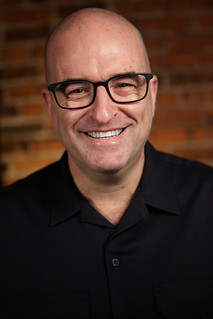 About the Interviewer
About the Interviewer
Greg Bennick (www.gregbennick.com) is a keynote speaker and long time coin collector with a focus on major mint error coins. Have ideas for other interviewees? Contact him anytime on the web or via instagram @minterrors.
To watch the complete video, see:
Kellen Hoard Interviewed for the NNP by Greg Bennick
(https://youtu.be/tBb-Bt4NR8k)
To read the complete transcript, see:
Kellen Hoard Interviewed for the NNP by Greg Bennick (Transcript)
(https://nnp.wustl.edu/library/book/641580)
To read the earlier E-Sylum article, see:
KELLEN HOARD INTERVIEW, PART ONE
(https://www.coinbooks.org/v27/esylum_v27n41a24.html)
KELLEN HOARD INTERVIEW, PART TWO
(https://www.coinbooks.org/v27/esylum_v27n40a13.html)
KELLEN HOARD INTERVIEW, PART THREE
(https://www.coinbooks.org/v27/esylum_v27n43a21.html)
KENTUCKY COLONEL MICHAEL MORAN
Author and CCAC member Mike Moran joins Dennis Tucker and Jeff Garrett as numismatic Kentucky Colonels. Congratulations. Here's the press release. -Editor
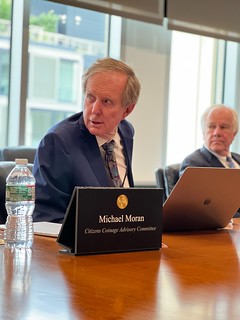 Kentucky governor Andy Beshear on August 20, 2024, commissioned award-winning numismatic author, lecturer, and researcher Michael F. Moran as a Kentucky Colonel, a distinction recognized as the highest honor awarded by the Commonwealth. The Honorable Order of Kentucky Colonels defines such a commission as "recognition of an individual's noteworthy accomplishments and outstanding service to our community, state, and nation."
Kentucky governor Andy Beshear on August 20, 2024, commissioned award-winning numismatic author, lecturer, and researcher Michael F. Moran as a Kentucky Colonel, a distinction recognized as the highest honor awarded by the Commonwealth. The Honorable Order of Kentucky Colonels defines such a commission as "recognition of an individual's noteworthy accomplishments and outstanding service to our community, state, and nation."
Mike Moran's work is known in Kentucky and his influence extends well beyond. He is a managing partner of Valley Lumber, a major building-products supplier based in Colorado. He is also active in the oil and gas industry. Among his charitable and community activities, Moran is former chair of the Advisory Board of the Art Museum at the University of Kentucky, and he has served as Treasurer, Trustee, and Executive Committee member of the Theodore Roosevelt Association.
On the federal level, he is currently in his third four-year term on the U.S. Treasury Department's Citizens Coinage Advisory Committee. The CCAC was established by Congress to advise the Secretary of the Treasury on the themes and designs of all U.S. coins and medals. As a senior member of this Committee, Moran serves as an informed, experienced, and impartial resource to the Treasury Secretary, representing the interests of American citizens. Most recently he served on a subcommittee advising the United States Mint on themes for circulating coinage celebrating the nation's 2026 semi-quincentennial.
In a letter to Governor Beshear, retired Whitman publisher Dennis Tucker wrote: "Michael Moran would make an exemplary ambassador for the Commonwealth of Kentucky—as he already has been for many years. Through his philanthropic work he embodies the tradition of service on behalf of others, and as an author, educator, and volunteer he commits himself to sharing knowledge as a way of building community and understanding."
Author, Researcher, and Numismatist
Knowledge and education are important aspects of Moran's numismatic calling. He regularly shares his research with many of the nation's numismatic associations, publishers, museums, and institutions. His Numismatist article on the survival of the San Francisco Branch Mint during the great earthquake of 1906 won the American Numismatic Association's Heath Literary Award. His books have earned recognition and awards from the Numismatic Literary Guild and the Professional Numismatists Guild.
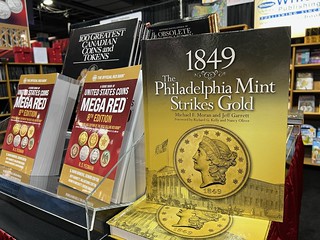 Moran has authored two books published by Whitman Publishing, with a third in production and expected to debut in 2025. His groundbreaking 480-page masterwork Striking Change: The Great Artistic Collaboration of Theodore Roosevelt and Augustus Saint-Gaudens (2008) studies one of the most dramatic and productive relationships in American numismatics. It explores the renaissance of United States coinage at the beginning of the twentieth century. Moran's research took him to numerous museums and archives, where he was able to shed new light on old "conventional wisdom" about presidential politics, urban design, monumental sculpture, and other areas of American life and culture. His next book, 1849: The Philadelphia Mint Strikes Gold (2018), won the Numismatic Literary Guild's "Best Specialized Book" award for U.S. coinage. It chronicles the trials and tribulations of the United States Mint in the first half of the nineteenth century and the tremendous impact that the 1848 discovery of gold in California had upon that institution and the nation as a whole. The third book in the series, When Coins Were King, reveals how silver and gold coins came to drive American politics in the late 1800s and early 1900s. In it, Moran also provides fresh insights into the relationship of Theodore Roosevelt and Augustus Saint-Gaudens.
Moran has authored two books published by Whitman Publishing, with a third in production and expected to debut in 2025. His groundbreaking 480-page masterwork Striking Change: The Great Artistic Collaboration of Theodore Roosevelt and Augustus Saint-Gaudens (2008) studies one of the most dramatic and productive relationships in American numismatics. It explores the renaissance of United States coinage at the beginning of the twentieth century. Moran's research took him to numerous museums and archives, where he was able to shed new light on old "conventional wisdom" about presidential politics, urban design, monumental sculpture, and other areas of American life and culture. His next book, 1849: The Philadelphia Mint Strikes Gold (2018), won the Numismatic Literary Guild's "Best Specialized Book" award for U.S. coinage. It chronicles the trials and tribulations of the United States Mint in the first half of the nineteenth century and the tremendous impact that the 1848 discovery of gold in California had upon that institution and the nation as a whole. The third book in the series, When Coins Were King, reveals how silver and gold coins came to drive American politics in the late 1800s and early 1900s. In it, Moran also provides fresh insights into the relationship of Theodore Roosevelt and Augustus Saint-Gaudens.
One of Mike Moran's greatest contributions to numismatics was the 1921 Silver Dollar Anniversary Act. Over the course of two years, he and current ANA president Thomas Uram worked with Congressman Andy Barr of Kentucky and Senator Mike Enzi of Wyoming. They wrote, lobbied for, and ultimately secured passage of the act, which was signed into law on January 5, 2021. The legislation ordered minting of new coins celebrating the 1921–2021 centennial of the last mintage of classic Morgan dollars and the first year of the Peace dollar. This program has introduced a new generation of Americans to two of the nation's most popular classic coins. Millions of the new silver dollars, recreating the old designs and eagerly sought by collectors, have been produced since 2021.
CCAC members Mike Moran (left) and Erik Jansen at Mint headquarters, September 27, 2018. Moran holds a new Cumberland National Seashore quarter dollar.
Volunteer and Philanthropist
Mike Moran has given his time and effort to many arts- and history-related nonprofits. He has lectured on the subject of numismatics and American history at the National Arts Club in New York City. He has volunteered as a speaker at the annual convention of the congressionally chartered American Numismatic Association, and has written cover articles for The Numismatist, the organization's official journal. He has also shared his research with the American Numismatic Society (New York).
Along with his wife, he has endowed the Dee Dee and Mike Moran Education Abroad Scholarship at the University of Kentucky. This scholarship is open to students who study German in a university-sanctioned program in any German-speaking country for a summer, semester, or academic year. He has recently initiated a similar scholarship for engineering students at his alma mater, Purdue University.
"I've known Mike Moran personally and professionally for almost twenty years," Dennis Tucker said. "I know him as a successful businessman, a savvy and clear-eyed advisor to the U.S. Treasury Department, and a dedicated researcher and writer. The Bluegrass State should be proud to number him among its most celebrated numismatic sons, just as I'm proud to have been his publisher over the course of my career."
Mike Moran's official commission as a Kentucky Colonel is a fitting tribute to his selfless commitment to education and philanthropy. Beyond that, it is a call to greater service for everyone who admires and supports his important and ongoing work.
To read the earlier E-Sylum articles, see:
DENNIS TUCKER NOW A KENTUCKY COLONEL
(https://www.coinbooks.org/v24/esylum_v24n18a20.html)
INTRODUCING COLONEL JEFF GARRETT
(https://www.coinbooks.org/v26/esylum_v26n03a10.html)
THE BOOK BAZARRE
NUMISMAGRAM MEDAL SELECTIONS: NOVEMBER 3, 2024
Jeremy Bostwick at Numismagram forwarded these four medals from his upload of new medallic art to his site. For all of the new items, please visit https://www.numismagram.com/inventory. -Editor
102647 | UNITED STATES & GERMANY. Colonial America and Preußen (Prussia) silver Medal. Issued 1763. The Treaty of Hubertusburg and the end of the Seven Years' War (French and Indian War in America) (44mm, 21.94 g, 12h). By Johann Leonhard Oexlein. IAM REDIRE AVDET (now she dares to return...), Germania standing facing, head right, holding scepter and grain ear; mountains and plowman in background; in two lines in exergue, GERMANIA / PACATA (...with Germany being at peace) // NVNCIA PACIS (the messenger of Peace), view of the Hubertusburg Palace; above, Fama (Rumor) flying right, blowing in one trumpet and holding another; D 15 FEBR MDCCLXIII in exergue. Edge: Plain. Betts 446; Pax in Nummis 595; Olding 931; Henckel 1658. PCGS AU-58. Pleasingly toned, with mostly gunmetal gray hues mixing with hints of gold and deep cobalt. Compare to an NGC AU-58 that realized a total of $504 in Heritage's March 2023 World Medals and Tokens Showcase Auction #61312, lot 22180 (and for which its current owner now wants at least $756), and a PCGS SP-61 (severely hairlined as well) that realized a total of $1,320 in the Stack's Bowers February 2022 CCO Auction, lot 73771. $595.
To read the complete item description, see:
102647 | UNITED STATES & GERMANY. Colonial America and Prussia silver Medal.
(https://www.numismagram.com/product-page/102647)
102942 | GREAT BRITAIN. Map of the World white metal Medal. Issued circa 1820 (73mm, 99.20 g, 12h). Unsigned, but commonly attributed to Thomas Halliday and possibly struck by Edward Thomason. Map of North and South America (Western Hemisphere), with lines of latitude and longitude crossing globe // Map of Europe, Asia, Africa and Australia (Eastern Hemisphere), with lines of latitude and longitude crossing globe. Edge: Plain. BHM –; Eimer 1139a. Mint State. A few scattered spots and marks, but great brilliance remaining for a scarce type that often shows the effects of pestering. $1,095.
To read the complete item description, see:
102942 | GREAT BRITAIN. Map of the World white metal Medal.
(https://www.numismagram.com/product-page/102942)
102940 | SPAIN. Córdoba. Mosque/Cathedral of Our Lady of the Assumption bronze Medal. Issued 1859. Most Remarkable Edifices of Europe series (59mm, 12h). By Jacques Wiener in Brussels and struck at the Geerts mint in Ixelles. Interior view of the cathedral from the southwest looking northeast; in five lines in exergue, MEZQUITA ERIGIDA 786 / POR ABD-EL-RAHMAN / CONVERTIDA EN IGLESIA / POR FERNANDO III / 1236. // Interior view of the former mosque with the three arches of the maqsura and the mihrab in the far distance; in two lines in exergue, CATEDRAL / DE CORDOBA. Ross M220 (R2); van Hoydonck 167; cf. Reinecke 59 (no date on rev.). PCGS SP-64. Glossy red-brown surfaces, with a great deal of luster radiating throughout. One of Wiener's more powerful and enticing types, and no doubt a premium-quality example with respect to others of the same grade level. Compare to an inferior example in Stack's Coin Galleries (10 September 2008), lot 1656 (which sold for a total of $1,035[!]). $795.
To read the complete item description, see:
102940 | SPAIN. Córdoba. Mosque/Cathedral of Our Lady bronze Medal.
(https://www.numismagram.com/product-page/102940)
102956 | BELGIUM. Brussels. Art Deco gilt bronze Award Medal. Issued 1958 for the Universal Exposition (80mm, 195.73 g, 12h). By Marcel Rau. EXPOSITION UNIVERSELLE INTERNATIONALE / ALGEMENE WERELDTENTOONSTELLING, BRVXELLES BRVSSEL, female bust facing, holding grain ear and raising hand; star and moon to upper right // Two nude males advancing slightly left; crescent moon, constellations, zodiac band, and clouds in background. Edge: Minor rim bruise noted for completeness, otherwise plain. Lippens 243. Choice Mint State. Brilliant gilt surfaces, with a charming matte aspect. $195.
To read the complete item description, see:
102956 | BELGIUM. Brussels. Art Deco gilt bronze Award Medal.
(https://www.numismagram.com/product-page/102956)
RICHARD ROSSA CARDBOARD SCRIP
Last week Jim Downey shared his recent acquisition of a large group of cardboard scrip. The Stack's Bowers November 14, 2024 Collectors Choice Online Auction includes a consignment of cardboard scrip from the collection of Richard Rossa. Here's a sampling. Great rarities at low estimates. Excellent opportunity to build the foundation of an important collection. -Editor
Galesburg, Illinois Chit. Sydney Myers & Company. 1862 10 Cents. Choice Uncirculated.
A chit contemporary to the American Civil War issued by Sydney Myers & Co out of Galesburg, Illinois. This institution also redeemed scrip notes (notably Watuga) from the surrounding areas based on what limited information can be found. This piece previously sold for $332.75 back in May 2001.
To read the complete lot description, see:
Galesburg, Illinois Chit. Sydney Myers & Company. 1862 10 Cents. Choice Uncirculated.
(https://auctions.stacksbowers.com/lots/view/3-1EOT8L/galesburg-illinois-chit-sydney-myers-company-1862-10-cents-choice-uncirculated)
Detroit, Michigan Chit. Campbell, Linn & Company. 1862 10 Cents. Extremely Fine.
A chit attributable to a prolific issuer of Civil War Tokens out of Detroit. Linn Campbell & Co. largely dealt in dry goods and millinery (women's hats) and operated out of 93 and 95 Woodward Avenue. A paper pull can be observed along the left margin and runs the narrow ve
To read the complete lot description, see:
Detroit, Michigan Chit. Campbell, Linn & Company. 1862 10 Cents. Extremely Fine.
(https://auctions.stacksbowers.com/lots/view/3-1EOT8S/detroit-michigan-chit-campbell-linn-company-1862-10-cents-extremely-fine)
Lot of (4) Massachusetts & New York Chits. Various Locations. ND Mixed Denominations. Fine to Very Fine.
A quartet of merchant chits from Massachusetts and New York. These pieces are attributable to four different institutions and have each seen a degree of circulation. The following businesses are represented within this lot:
Fisher & Lanphier - Restauranteurs: 14 Niles Block, City Hall Avenue (New York City?)
T. A. Knickerbacker - Union Bridge Company: Address Unknown (Waterford, New York)
George E. Baker - Grocer & Confectioner: High St (Dedham, Massachusetts)
Great Eastern - Shipping?: Address Unknown (Location Unknown)
To read the complete lot description, see:
Lot of (4) Massachusetts & New York Chits. Various Locations. ND Mixed Denominations. Fine to Very Fine.
(https://auctions.stacksbowers.com/lots/view/3-1EOT8Z/lot-of-4-massachusetts-new-york-chits-various-locations-nd-mixed-denominations-fine-to-very-fine)
Lot of (2) New York City, NY Chits. John Rufer & Niles Eames. ND 1 & 3 Cents. Very Fine.
A pair of merchant chits issued by separate businesses out of New York City. The pieces in this lot were issued by the following businesses:
Niles Eames - Butcher: 94 Eight Avenue - Orange 2 Cents (New York City)
John Rufer - Merchant: 44 Greenwich - Square 3 Cents (New York City)
To read the complete lot description, see:
Lot of (2) New York City, NY Chits. John Rufer & Niles Eames. ND 1 & 3 Cents. Very Fine.
(https://auctions.stacksbowers.com/lots/view/3-1EOT9D/lot-of-2-new-york-city-ny-chits-john-rufer-niles-eames-nd-1-3-cents-very-fine)
New York Chit. 5th Ward Hotel. ND 2 Cents. About Uncirculated.
Attributable to M.M. Laird and the Fifth Ward Hotel, this piece was issued amidst the scarcity of small change that accompanied the American Civil War and could be redeemed in currency absent a specified amount. Initials M.M.L. penned in fine scrip on the verso opposite mounting remnants. The issuer of this piece was also a noted issuer of Hard Times Tokens. Previously offered as Lot 4313 as part of the wider Ford Collection (Part X).
To read the complete lot description, see:
New York Chit. 5th Ward Hotel. ND 2 Cents. About Uncirculated.
(https://auctions.stacksbowers.com/lots/view/3-1EOTD0/new-york-chit-5th-ward-hotel-nd-2-cents-about-uncirculated)
To read the earlier E-Sylum article, see:
NOTES FROM E-SYLUM READERS: OCTOBER 27, 2024 : Civil War Cardboard Scrip Discovery
(https://www.coinbooks.org/v27/esylum_v27n43a13.html)
SBG NOVEMBER 2024 NUMISMATIC AMERICANA
Here are some medal highlights in Stack's Bowers upcoming November 2024 Numismatic Americana & Early American Coins Showcase sale. Some great pieces here. -Editor
1777 B. Franklin of Philadelphia Medal. Unidentified English Medalist. Betts-547, Greenslet GM-40, Adams-Bentley 14. Bronze. Specimen-63 BN (PCGS). The origins of the 1777 B. Franklin of Philadelphia medal are obscure. The distinctive portrait, and the unusual basining of the reverse, bring to mind a group of medals that are clearly related: the 1778 Washington "Voltaire" medal, the 1777 Chevalier D'Eon medal, and the 1776 David Hume medal. Tony Lopez did a good job punchlinking this group in the June 2008 MCA Advisory, and finding that a group of medals shares a punchset is good evidence if not a slam dunk that they come from the same workshop. The August 2008 issue of the same journal features a detailed examination by English medal mensch Christopher Eimer, reflecting on the conversation he and Richard Margolis had shared years earlier discussing many of the same connections among these medals, while cautioning that little evidence connects these medals to the liberal-minded ceramics makers Wedgwood and Bentley.
Provenance: Ex New Netherlands Coin Company, January 23, 1963; John J. Ford, Jr.; our (Stack's) sale of the John J. Ford, Jr. Collection, Part XIV, May 2006, lot 337.
To read the complete item description, see:
1777 B. Franklin of Philadelphia Medal. Unidentified English Medalist. Betts-547, Greenslet GM-40, Adams-Bentley 14. Bronze. Specimen-63 BN (PCGS).
(https://auctions.stacksbowers.com/lots/view/3-1E2VY1/1777-b-franklin-of-philadelphia-medal-unidentified-english-medalist-betts-547-greenslet-gm-40-adams-bentley-14-bronze-specimen-63)
"1781" (1783) Libertas Americana Medal. Original. Paris Mint. By Augustin Dupre. Betts-615, Adams-Bentley 15. Silver. Thick Planchet. MS-61 (PCGS). No other medal in the canon of American numismatics is invested with so much history and importance as the Libertas Americana medal. It followed the declaration of American independence, whose date is placed in the obverse legend, and the support of France in the American cause. The two greatest American victories, that of Gates at Saratoga and Washington at Yorktown, are referenced with dates in the reverse exergue. The British armies defeated on those dates, Burgoyne's force at Saratoga and that of Cornwallis at Yorktown, are incorporated into the reverse allegory as the snakes strangled by Hercules in his crib. In that allegory, France is depicted as Minerva, defending the infant from the lioness, Great Britain, whose tail curls between her hind legs. The obverse design influenced many of the depictions of Liberty that would come from the first United States Mint, directly inspiring the Liberty Cap design found on copper half cents and cents in the 1790s. Dozens, perhaps hundreds, of later American medals and tokens used the design, from privately issued business cards to the United States Mint's 1945 Assay Commission medal. Its image was featured on contemporary engravings and textiles, and examples could be found in the 18th century in the collections of Thomas Jefferson, George Washington, John Adams, and more. No founding father is as closely associated with the medal, of course, as Benjamin Franklin. The medal was his brainchild and pet project, and every specimen that survives traces its provenance to him.
Provenance: From the Bernardi Collection. Acquired by our consignor in 1981 shortly after discovery on a farm in the Amish community. This is its first known public offering.
To read the complete item description, see:
"1781" (1783) Libertas Americana Medal. Original. Paris Mint. By Augustin Dupre. Betts-615, Adams-Bentley 15. Silver. Thick Planchet. MS-61 (PCGS).
(https://auctions.stacksbowers.com/lots/view/3-1E2W18/1781-1783-libertas-americana-medal-original-paris-mint-by-augustin-dupre-betts-615-adams-bentley-15-silver-thick-planchet-ms)
"1783" (ca. 1808) Washington / Franklin Treaty of Paris Sansom Medal. Betts-617, Musante GW-92, Baker-58, Greenslet GM-82, Julian CM-5. Silver. Specimen-62 (PCGS). This is the fourth and final entry in Joseph Sansom's series celebrating the History of the Revolution, the title he himself used on the case that held the three medals of the series he retained for himself (a set that we have had the pleasure of selling at auction intact more than once). The C.C.A.U.S. (Commander in Chief, Armies of the United States) medal was the first of the four, followed by the Presidency Relinquished medal, the Franklin / American Beaver medal, and finally, this one, issued at the end of the series in 1808. Unlike the bronzed copper specimens, silver examples do not appear to have been restruck. They are immensely historic, engraved by the talented John Reich, and rightfully prized by collectors to this day.
Provenance: From our (Bowers and Merena's) sale of the David W. Dreyfuss Collection, April 1986, lot 5405.
To read the complete item description, see:
"1783" (ca. 1808) Washington / Franklin Treaty of Paris Sansom Medal. Betts-617, Musante GW-92, Baker-58, Greenslet GM-82, Julian CM-5. Silver. Specimen-62 (PCGS).
(https://auctions.stacksbowers.com/lots/view/3-1E2W20/1783-ca-1808-washington-franklin-treaty-of-paris-sansom-medal-betts-617-musante-gw-92-baker-58-greenslet-gm-82-julian-cm-5-)
"1781" (ca. 1789) Lieutenant Colonel William Washington, Battle of the Cowpens Medal. Original. Paris Mint. By Pierre Simon DuVivier. Betts-594, Adams-Bentley 11. Silver. AU-53 (PCGS). When this piece is added to the three extant silver pieces that were accurately included in the Adams-Bentley census, it makes a total population of just four survivors, of which just three are in private hands. Remarkably, this is the third of those three to cross our podiums.
It's more than possible that one of the two we've sold, or this one, was William Washington's own.
Silver Comitia Americana medals are among the most powerfully desirable items in the realm of American numismatics. Distributed in tiny numbers to crowned heads and learned institutions of Europe, along with their Congressionally authorized recipient in this case, these original medals were not struck on spec or as collector items by the Paris Mint. Their production was intentional and their meager distribution was intentionally special, shepherded to completion by Founding Fathers like Benjamin Franklin, Thomas Jefferson, and William Short. No one will ever complete a set of Comitia Americana medals in silver, and even the most "common" of them are extraordinary rarities.
Provenance: From Wayte Raymond's sale of the W.W.C. Wilson Collection, Part I, November 1925, lot 811.
To read the complete item description, see:
"1781" (ca. 1789) Lieutenant Colonel William Washington, Battle of the Cowpens Medal. Original. Paris Mint. By Pierre Simon DuVivier. Betts-594, Adams-Bentley 11. Silver. AU-53 (PCGS).
(https://auctions.stacksbowers.com/lots/view/3-1E2W4K/1781-ca-1789-lieutenant-colonel-william-washington-battle-of-the-cowpens-medal-original-paris-mint-by-pierre-simon-duvivier-be)
1825 John Quincy Adams Inaugural Medal. Julian PR-5, Neuzil-45. Silver. Very Fine, Holed. Michael Hodder commented in the description of the Ford piece that this medal was "undoubtedly, extremely rare in silver," and the fact that we have seen just two since, including this one, suggests he was quite correct. Our sale of the fabulous Garrett Collection included a silver specimen that had a prominent oxidation spot behind Adams' head and still realized nearly $10,000 all the way back in 1981. Other examples are in the collections of the Massachusetts Historical Society and the American Numismatic Society. Clearly, opportunities to acquire this medal in silver are precious few and very far between, regardless of grade.
To read the complete item description, see:
1825 John Quincy Adams Inaugural Medal. Julian PR-5, Neuzil-45. Silver. Very Fine, Holed.
(https://auctions.stacksbowers.com/lots/view/3-1E2WDD/1825-john-quincy-adams-inaugural-medal-julian-pr-5-neuzil-45-silver-very-fine-holed)
1869 New York State Agricultural Society Award Medal. Harkness-Ny 392, Julian AM-61. Gold. Specimen-63 (PCGS). Julian reports that the United States Mint did not receive the dies (two pairs) for this type until 1885, so the present example must be one of those specimens that the author states were struck prior to 1870 at private mints. Indeed, the dies for this type were prepared in the 1840s by William Joseph Taylor in Birmingham, England, using designs supplied by Francis Rotch, Esq., in fulfillment of an order placed by the Society. The latter received the dies, as well as the first medals struck, in 1845. This is only the second gold impression that we have offered in recent memory, and it is the counterpart to the specimen awarded to Walcott & Campbell in 1870 that realized $8,400 in our June 2024 Showcase Auction. It was also certified Specimen-63 by PCGS.
To read the complete item description, see:
1869 New York State Agricultural Society Award Medal. Harkness-Ny 392, Julian AM-61. Gold. Specimen-63 (PCGS).
(https://auctions.stacksbowers.com/lots/view/3-1E2WPH/1869-new-york-state-agricultural-society-award-medal-harkness-ny-392-julian-am-61-gold-specimen-63-pcgs)
(1913) Carnegie Hero Fund Medal. Gold. Awarded to Julius B. Gordon. Mint State, Engraving Effaced. While we have handled numerous bronze examples over the years, not surprisingly given their high distribution, our online archives back to 2009 include only three different silver examples, awarded in 1907, 1909 and 1920. This is the first gold award medal that we can recall offering, and it is a particularly intriguing specimen. While clearly an awarded example, the inscription to the recipient on the cartouche has been almost completely effaced by numerous tiny digs that, when viewed as a whole, provide a stippled effect to the surface in that area. Close inspection of the penultimate line in the inscription with a loupe, however, reveals traces of the following letters: ER CK OKLA. These are the letters for Frederick, Oklahoma. The third-to-last and penultimate gold Carnegie medals were awarded in 1913 to residents of Frederick, Oklahoma - Charles Zolninger and Julius B. Gordon - for helping to rescue Oliver H. Brewer and Alvah Dean from a cave-in in a well in that town on October 28, 1913. Zolninger and Gordon also received a money award. Two other men (William H. Reed, Sr. and John F. Steinbock) received silver medals and a sum of money for the same rescue.
To read the complete item description, see:
(1913) Carnegie Hero Fund Medal. Gold. Awarded to Julius B. Gordon. Mint State, Engraving Effaced.
(https://auctions.stacksbowers.com/lots/view/3-1E2WQO/1913-carnegie-hero-fund-medal-gold-awarded-to-julius-b-gordon-mint-state-engraving-effaced)
1800 Charleston Slave Hire Badge. Mechanic. No. 349. By Ralph Atmar. Copper. Very Fine. The 1800-dated tags are very distinctive within the Charleston slave tag series. They are the only tags made by Ralph Atmar and the only ones made in this small octagonal format. Known occupations of 1800 tags are House Servant, Porter, Fisher, and Mechanic. Out of the 146 tags in the National Museum of African American History and Culture collection, only five are from Atmar's 1800 emission: two Mechanics, two Fishers, and a House Servant. We've sold 1800 Porter No. 423 twice, once in January 2006 and later in the August 2023 Syd Martin sale, where it brought $6,600 despite being broken in half and backed. Heritage has sold a Porter (the same tag on two occasions), a Fisher, and a Mechanic. The 1800 Fisher No. 69 from the Jeff Pitts collection brought $20,700 in our (Bowers and Merena's) November 2001 sale.
To read the complete item description, see:
1800 Charleston Slave Hire Badge. Mechanic. No. 349. By Ralph Atmar. Copper. Very Fine.
(https://auctions.stacksbowers.com/lots/view/3-1E2WTR/1800-charleston-slave-hire-badge-mechanic-no-349-by-ralph-atmar-copper-very-fine)
Undated (1652) NE Shilling. Noe 1-A, Salmon 1-B, W-40. Rarity-6+. VF-30 (PCGS). The NE shillings were struck between initial authorization on June 11, 1652 and the order to change the design on October 19, 1652, though it seems likely production continued after the legal decree of the new designs, at least until new dies were made and a press to use them was readied. There is no argument than the New England shillings were the first coins struck in what became the United States. Over the period of six months or so when these were produced, only the very rare Noe 1-D (four known) appears to have preceded this variety - and the die state of this specimen shows it was struck early among the Noe 1-As. While New England shillings are prime trophies for specialists in colonial coins, this primacy, historicity, and rarity makes collectors of all sorts desire these greatly. It's no wonder four of these are in museums in the United Kingdom, as they are of dramatic importance to collectors of British coins as well.
To read the complete item description, see:
Undated (1652) NE Shilling. Noe 1-A, Salmon 1-B, W-40. Rarity-6+. VF-30 (PCGS).
(https://auctions.stacksbowers.com/lots/view/3-1E2WVL/undated-1652-ne-shilling-noe-1-a-salmon-1-b-w-40-rarity-6-vf-30-pcgs)
Undated (1652) NE Threepence. Noe 1-A, Salmon 1-A, W-1. Rarity-8. EF-45 (PCGS). CMQ-X. The history of this coin is dramatic, important, and shared with other rare products made in Hull and Sanderson's mint after May 1652. The General Court of Massachusetts Bay established a mint for silver coins by terms of their Mint Act of May 26/27, 1652. Their choice for mintmaster, silversmith John Hull, memorialized his appointment in his diary:
Upon occasion of much counterfeit coin brought in the country, and much loss accruing in that respect (and that did occasion a stoppage of trade), the General Court ordered a mint to be set up, and to coin it, bringing it to the sterling standard for fineness, and for weight every shilling to be three pennyweight; i.e., 9d at 5s per oz. And they made choice of me for that employment; and I chose my friend, Robert Sanderson, to be my partner, to which the Court consented.
Hull was paid as a proportion of the coins he struck, and his mint would recoin any sort of silver that depositors supplied. In other words, a citizen of Boston could deliver other sorts of coins (including those that were worn out or counterfeit, as long as they were silver), flatware, hollowware, or anything else, and Hull would return to them coins of good, properly assayed silver minus a small percentage (6.5%) to pay for Hull's expenses and a smaller percentage (1.25%) to cover silver lost in the assaying process. The 8% charges allowed every Massachusetts citizen to turn their unwanted silver or unspendable coins into easy, ready cash.
The primary effort Hull exerted was in the assaying process, which required significant expertise, acquisition of chemicals and equipment, and careful attention to the work. Coining the coins was relatively easy: silver sheet was clipped down to proper size and weight, and two stamps were applied. The stamp for the obverse was a simple NE hallmark, representing New England, and the stamp for the reverse denoted the denomination: XII for shillings (12 pence), VI for a sixpence, and III for a threepence. The same amount of work was required for each coin, regardless of denomination.
It is not hard to imagine why NE shillings are more numerous than NE sixpence or NE threepence.
Provenance: From the Janssen Sastra Collection. Discovered in the Netherlands in 2016.
To read the complete item description, see:
Undated (1652) NE Threepence. Noe 1-A, Salmon 1-A, W-1. Rarity-8. EF-45 (PCGS). CMQ-X.
(https://auctions.stacksbowers.com/lots/view/3-1E2WWG/undated-1652-ne-threepence-noe-1-a-salmon-1-a-w-1-rarity-8-ef-45-pcgs-cmq-x)
1652 Oak Tree Shilling. Noe-1, Salmon 1-A, W-430. Rarity-3. IN at Left. AU-50 (PCGS). Very typical centering for a Noe-1 Oak Tree. Most obverse letters run to the edge, although the reverse is better centered. Clear outlines of the reverse die edge visible at top and bottom, none on obverse. This coin is evidence that the obverse die was broader than the reverse because when it was trimmed at the mint it lost some of its outer design. Edge ragged at right on obverse, as made. Obvious S bend, as made, but without any elongation to the letters. No reverse die break through the tops of the letters in NEW, and so an earlier state of these dies. The collector seeking a single Oak Tree shilling would be wise to give this piece serious consideration.
Provenance: From the Ross Family Collection. Earlier ex S.H. & H. Chapman's sale of the Harlan P. Smith Collection, May 1906, lot 4; S.H. Chapman's sale of the William Gable Collection, May 1914, lot 149; Stack's, May 12, 1987, privately to the following; our (Stack's) sale of the Hain Family Collection of Massachusetts Silver Coins, January 2002, lot 13.
To read the complete item description, see:
1652 Oak Tree Shilling. Noe-1, Salmon 1-A, W-430. Rarity-3. IN at Left. AU-50 (PCGS).
(https://auctions.stacksbowers.com/lots/view/3-1E2WWR/1652-oak-tree-shilling-noe-1-salmon-1-a-w-430-rarity-3-in-at-left-au-50-pcgs)
1652 Pine Tree Threepence. Noe-37, Salmon 2a-B, W-640. Rarity-5. Without Pellets at Trunk. MS-61 (PCGS). When Walter Breen cataloged the grounder Kendall coin in its earlier appearance in Superior's 1974 Ruby sale, he called it "unquestionably above average condition for the variety," which, while perhaps not true, points out that most examples from these dies have not survived in tip-top shape. Partrick's coin, ex Hain, was certainly exceptional - it sold in Heritage's January 2015 Signature Auction certified NGC/CAC AU-53. Syd Martin's was unexceptional in a PCGS Fine Details holder due to damage, and a perusal of our archives shows that most others that we have offered in the last couple decades have been impaired for one reason or another. The Boyd-Ford specimen offered here is in a category all its own - far and away the finest that we have seen from these dies, and a coin that would serve as a leading highlight in any cabinet.
Provenance: Ex F.C.C. Boyd; John J. Ford, Jr.; our (Stack's) sale of the John J. Ford, Jr. Collection, Part XII, October 2005, lot 147. The plate coin for the Noe-37 dies in the 2010 Salmon reference on Massachusetts Bay Colony silver coinage, pp. 232-233.
To read the complete item description, see:
1652 Pine Tree Threepence. Noe-37, Salmon 2a-B, W-640. Rarity-5. Without Pellets at Trunk. MS-61 (PCGS).
(https://auctions.stacksbowers.com/lots/view/3-1E2X9L/1652-pine-tree-threepence-noe-37-salmon-2a-b-w-640-rarity-5-without-pellets-at-trunk-ms-61-pcgs)
Undated (1659) Lord Baltimore Sixpence. Hodder 2-C, W-1060. Rarity-5. Small Bust, No Stop. Silver. EF-45 (PCGS). Choice and original Lord Baltimore sixpence such as this are highly elusive, a fact that the discovery of 19 pieces in a single English hoard in 2002 did little to change. Few of those pieces showed this kind of strike, most were wiped or cleaned, and none showed this sort of richly original toning. At least one example of this type has been recovered in the ground in North America (in southern Virginia), and many are well circulated, definitive proof that this type achieved its purpose of colonial American circulation in the 17th century.
Provenance: From the Ross Family Collection. Earlier from Heritage's Atlanta, George Signature Sale of August 2001, lot 5015.
To read the complete item description, see:
Undated (1659) Lord Baltimore Sixpence. Hodder 2-C, W-1060. Rarity-5. Small Bust, No Stop. Silver. EF-45 (PCGS).
(https://auctions.stacksbowers.com/lots/view/3-1E2XAI/undated-1659-lord-baltimore-sixpence-hodder-2-c-w-1060-rarity-5-small-bust-no-stop-silver-ef-45-pcgs)
1785 Connecticut Copper. Miller 3.1-F.3, W-2320. Rarity-6+. Bust Right. EF-40 (PCGS). One of several significant Connecticut coppers we are offering in this sale, and a standout example of this elusive and challenging Miller number. The letters AUCTO on the obverse and DE on the reverse are not struck up, quite probably due to axial misalignment of the dies. Where the original surface of the coin can be seen (above the effigy's head and in the right obverse field, in particular), the detail and level of preservation are solidly EF. Obverse slightly striated diagonally from 12 o'clock to 6:30, surface rough at the letters NN in CONNEC, incomplete clip and edge burr outside the final C. Reverse more heavily striated, right portion with two near parallel linear flaws, center with light scratches and further stray flaws, another linear flaw runs from the seated figure's hand to the base of the letter N in INDE. The census for this variety has crept up to about 14 coins in recent years, but this remains the finest known. It is better than the Perkins duplicate, ex Norweb, the ANS and both CNL coins, as well as Taylor:2299. Both the Oechsner and Ford collections were missing this Miller number entirely.
Provenance: Ex Colonial Trading Company, January 1995; our (Stack's) sale of the George C. Perkins, Esq. Collection, January 2000, lot 188; Jon Hanson, January 12, 2000; Donald G. Partrick; Heritage's sale of the Donald G. Partrick Collection of Connecticut Coppers, November 2020, lot 44005, as NGC EF-40 BN, and accompanied by NGC insert #2048943-005 from that earlier certification.
To read the complete item description, see:
1785 Connecticut Copper. Miller 3.1-F.3, W-2320. Rarity-6+. Bust Right. EF-40 (PCGS).
(https://auctions.stacksbowers.com/lots/view/3-1E2Y4Q/1785-connecticut-copper-miller-31-f3-w-2320-rarity-6-bust-right-ef-40-pcgs)
1786 Connecticut Copper. Miller 5.11-S, W-Unlisted. Unique. Mailed Bust Left, Sword Hilt and Guard Reverse. VG-10 (PCGS). Stack's Bowers Galleries is pleased to present the unique Miller 5.11-S, the first new 1786 Connecticut copper variety discovered since 2008. This exciting coin pairs two previously known dies in the Connecticut copper series. Obverse 5.11 was previously known only in the 5.11-R pairing, while reverse S was previously known paired with obverses 4.2, 5.14, and 5.15. With four known pairings, reverse S is now tied with reverse G as the most prolific reverse among 1786 varieties. When this coin surfaced on the first day of the January 2023 FUN Convention, it became the first new 1786 variety discovered since 2008, when 4.1-H.2 was identified. Since there are now two specimens known for 4.1-H.2, 5.11-S is currently the only unique die pairing among 1786 Connecticut coppers. This is its first auction appearance - an opportunity that represents what will very likely be a once in a lifetime bidding opportunity for the collector striving to complete a set of all 357 confirmed Connecticut copper varieties. Only the most aggressive bidding strategy will prevail here.
Provenance: Discovered at the January 2023 FUN Convention.
To read the complete item description, see:
1786 Connecticut Copper. Miller 5.11-S, W-Unlisted. Unique. Mailed Bust Left, Sword Hilt and Guard Reverse. VG-10 (PCGS).
(https://auctions.stacksbowers.com/lots/view/3-1E2Y7X/1786-connecticut-copper-miller-511-s-w-unlisted-unique-mailed-bust-left-sword-hilt-and-guard-reverse-vg-10-pcgs)
1786 New Jersey Copper. Maris 12-G, W-4790. Rarity-4. Date Under Plow, No Coulter, Shaggy Mane. EF-45 (PCGS). There are a fair number of Maris 12-Gs around, certainly more than most of the No Coulter combos, and at least a handful of them are pretty nice. The Spiro-Oechsner coin is ranked number one, followed by a small number of EFs, which listing needs to include this one. The Syd Martin coin is ranked fifth in the Siboni-Howes-Ish census, and it realized $44,400 in our Summer 2022 Global Showcase Auction, due no doubt in part to the notation in our description that "your cataloger would rank it above at least two of those ranked at higher positions based upon its various levels of appeal and near perfection for the grade." This coin is nearly the equal to the Martin coin in most respects, and is worthy of the strong bids.
Provenance: From the Ross Family Collection. Earlier from McCawley-Grellman's Ninth Annual C-4 Convention Sale, November 2003, lot 385.
To read the complete item description, see:
1786 New Jersey Copper. Maris 12-G, W-4790. Rarity-4. Date Under Plow, No Coulter, Shaggy Mane. EF-45 (PCGS).
(https://auctions.stacksbowers.com/lots/view/3-1E2YNT/1786-new-jersey-copper-maris-12-g-w-4790-rarity-4-date-under-plow-no-coulter-shaggy-mane-ef-45-pcgs)
1788 New Jersey Copper. Maris 50-f, W-5475. Rarity-3. Head Left. EF-40 (PCGS). Obverse die swell in right field, as usual for the variety, subsidiary break through the letters REA in CAESAREA to the left plow handle, reaching to date. Reverse die perfect. This is a popular Maris number for type purposes, but with the quality offered here it is quite rare. Ranked No. 8 in the 2013 Siboni-Howes-Ish Condition Census, and also the plate coin for these dies in that reference.
Provenance: From the Ross Family Collection. Earlier ex Henry Chapman's sale of the George M. Parsons Collection, June 1914, lot 271; Hillyer C. Ryder; F.C.C. Boyd; our (Bowers and Merena's) Frontenac Sale, November 1991, lot 185. The plate coin for the Maris 50-f dies in the 2013 Siboni-Howes-Ish reference on New Jersey coppers, p. 404.
To read the complete item description, see:
1788 New Jersey Copper. Maris 50-f, W-5475. Rarity-3. Head Left. EF-40 (PCGS).
(https://auctions.stacksbowers.com/lots/view/3-1E2YU0/1788-new-jersey-copper-maris-50-f-w-5475-rarity-3-head-left-ef-40-pcgs)
Undated (ca. 1785) Bar Copper. W-8520. Rarity-4. MS-62 BN (PCGS). The Bar copper is perhaps the early American coin best equipped to illustrate two great narratives of the Revolutionary-era: the military struggle for independence and the economic struggle against crummy coppers. Both the obverse and reverse designs of the Bar coppers were borrowed directly from buttons worn by Continental Army soldiers. The obverse design was commonplace throughout the war on the coats and vests of soldiers from New England to the Carolinas, making this design instantly familiar to most who encountered it. The lifespan of those buttons was longer than the circulation life of a Bar copper, however. The Bar coppers did meet with initial success in the young United States, where a dearth of circulating specie meant that they were eagerly accepted in commerce. At the time of their introduction, however, these coins were among the most underweight of the post-Revolutionary coppers, sometimes weighing as little as half of a Fugio cent. When the Copper Panic of 1789 hit New York, the Hudson Valley, Philadelphia, New Haven, and Boston, these were among the first coppers to be tossed from circulation, which is why AU Bar coppers are more common than VGs. Those AU coins vary widely in quality though and, of course, true Mint State pieces such as this are noteworthy rarities. This is certainly one of the nicest to come on the market in recent years.
To read the complete item description, see:
Undated (ca. 1785) Bar Copper. W-8520. Rarity-4. MS-62 BN (PCGS).
(https://auctions.stacksbowers.com/lots/view/3-1E2Z9W/undated-ca-1785-bar-copper-w-8520-rarity-4-ms-62-bn-pcgs)
1818 New Spain (Texas) Jola Token, or 1/2 Real. W-8540. Small Planchet. EF-45 BN (NGC). Interestingly for such a rare issue, there are several known die varieties of the 1818 jolas. All examples bear the same basic design, which is virtually identical to that used to produce Barrera's 1817 coinage. The obverse exhibits the initials of the issuer (for the 1818 coins J.A.G.) above, the fractional denomination 1/2 (for 1/2 real, oriented sideways) in the middle and the date below. The reverse design is very simple with the five pointed Lone Star of Texas stamped into the planchet. A small raised dot is present near the center of the star. The jolas of 1817 and 1818 are believed to represent the earliest use of the Lone Star symbol of Texas. The De la Garza coinage of 1818 is also known on both small and large size planchets.
Provenance: From the Ross Family Collection. Earlier from our (Bowers and Merena's) ANA Sale of the Millennium, August 2000, lot 181.
There are many great rarities in this group, but this lot particularly stands out to me. I've seen fakes, but never held a real one in my hand. Important relic of numismatic history. Are there more examples out there waiting to be discovered? -Editor
To read the complete item description, see:
1818 New Spain (Texas) Jola Token, or 1/2 Real. W-8540. Small Planchet. EF-45 BN (NGC).
(https://auctions.stacksbowers.com/lots/view/3-1E2ZHT/1818-new-spain-texas-jola-token-or-12-real-w-8540-small-planchet-ef-45-bn-ngc)
1787 Fugio Cent. Pointed Rays. Newman 9-S, W-6765. Rarity-6. STATES UNITED, 4 Cinquefoils. AU-53 (PCGS). Exceptional quality for this rare and conditionally challenging Newman number. The 9-S die pairing was not known to Newman in his original 1949 article on the "Varieties of the Fugio Cent," and though it has dropped in rarity from R-7+ in the early 1980s to a solid R-6 today, it remains difficult to find an example, much less a decent one. There are fewer than a dozen appearances in our archives for the last 20 or so years, some of which are for the same coin. Mos of those were VF-20 or less, one was a PCGS AU-50. The offered coin is not included in the 2016 Retz census, but based on its certified grade and overall quality it is comfortably within the Condition Census.
Provenance: Ex Heritage's sale of the Oak Collection of American Colonial Coinage, September 2005 Long Beach Signature Auction, lot 503; Kevin Vinton, August 17, 2018.
To read the complete item description, see:
1787 Fugio Cent. Pointed Rays. Newman 9-S, W-6765. Rarity-6. STATES UNITED, 4 Cinquefoils. AU-53 (PCGS).
(https://auctions.stacksbowers.com/lots/view/3-1E307O/1787-fugio-cent-pointed-rays-newman-9-s-w-6765-rarity-6-states-united-4-cinquefoils-au-53-pcgs)
To read the earlier E-Sylum article, see:
1913 GOLD CARNEGIE HERO FUND MEDAL
(https://www.coinbooks.org/v27/esylum_v27n42a26.html)
SOVEREIGN RARITIES WORKMAN COLLECTION, PART 3
Sovereign Rarities of London UK are proud to present for auction on the afternoon of November 19th 2024 the Bernard Workman Collection of Bronze Penny Rarities 1860-1967 – a scintillating selection of forty of the most elusive pennies from the reigns of Queen Victoria to Queen Elizabeth II, including the extremely rare – one of two known – 1922 Specimen strike Penny with a Satin finish featuring a 1927 onward style reverse. -Garrett

George V (1910-36) Bronze Satin Finish Specimen Penny 1922 with later 1927 onward style reverse NGC SP64BN Satin £6,000-£8,000
In last week's E-Sylum we showcased the finest currency Penny of 1922 with the later reverse, this week we exhibit the Satin Finish specimen coin which has some subtle differences to the reverse from the currency version. The main difference being with the distance between the upward flourish at the rear of Britannia's helmet and the plume beyond as well as other sharpened differences. The Satin finish patterns were completely unknown to UK collectors until the 1990s when the two only known examples turned up together as an obverse and reverse from a Specimen set with satin finishes supplied to the South Africa Mint Museum back in 1924. The colonial mint commenced work in Pretoria in 1923 with an extremely rare issue of currency Sovereigns and became more established by 1924. Seemingly two Specimen sets of coins were ordered from the Royal Mint London though a record does not survive, and the coins subsequently displayed in Pretoria. The coins ranging from a Halfcrown, Florin, Shilling, Sixpence, Threepence, Penny, Halfpenny and Farthing all have satin finishes and all dated 1924 except the Penny. The Threepence being of especial interest as there were no British currency threepence issued for this date, only as maundy money. The Penny could not be dated 1924 as there were no 1924 Pennies made that year. The nearest date to supply was 1922 and it was coupled with this later style reverse which was adopted to currency properly from 1927 onwards and for this satin finish Penny slightly different to the few currency versions of the 1922 Penny with 1927 reverse. It would seem the satin finish piece therefore came before what would become the adopted reverse from 1927 onwards due to the subtle differentiation explained above. The other example of the satin finish specimen is in a privately held complete set still, the coin offered here being from the set that was broken up for individual sale. The complete set was auctioned by Heritage in New York in 2004, the individual satin finish specimen Penny we have here has never been auctioned individually and slabbed as NGC SP64 brown satin with a £6,000-£8,000 estimate it will be interesting to see what results on 19th November 2024.
One of the classic rarities of the 1870s of which very few survive to this day is the narrow date format Penny of 1877. Much more common is the usual currency wide date piece. Believe it or not this narrow date example is one of the better survivors though it did not receive a straight grade from NGC as it is damaged by multiple scratches, the date is clear and it is estimated to sell for £3,000-£4,000 on November 19th.
We feature herewith one of the five bronze Patterns in the Bernard Workman Collection with the coronet head obverse by T. J. Minton after the model by sculptor W. Theed who was a designer for Wedgewood. Though this obverse design was never adopted for British currency similar styled pieces did appear for Malta, British Honduras and the Strait Settlements. Minton became Resident Engraver at the Mint from 1865 until he died when the post was made defunct. This bronze Pattern is dated 1870 and is graded as PF64 red and brown on an estimation of £5,000-£7,000
Following on from the previous two E-Sylum articles, this week we feature the last die number of the three different ones in the Bernard Workman collection. The small die number below the 8 and 6 of the date was a way of marking the Penny and its progress form manufacture in the dies from a relevant operator to its eventual release into circulation. Only four different die numbers are known and the collection contains numbers 2, 3 and 4 with two examples of number 3. All the survivors are in circulated condition and this number 2 example has not been straight graded but is nevertheless a British VF grade overall estimated at £5,000-£7,000 for November 19th.
Above we have seen the 1870 Bronze Pattern Penny, well here is the 1862 version, again by Minton produced in the year the previous Resident Engraver George Wyon passed away. Though Minton did not officially become Resident Engraver until 1865. These wonderful renditions of the Queen with a coronet in her hair were never adopted for British coins but versions of it appeared on some colonial pieces as mentioned above. This 1862 dated example is graded PF64 brown and estimated at £2,000-£3,000.
The third and final overdate in the Bernard Workman collection following on from those featured over the last two weeks is this 1861 where the 6 is struck over an 8. Highly unusual there are scant few survivors and this coin does exhibit some rim damage so has not straight graded. It is estimated conservatively at £600-800 for November 19th.
An unusual die combination for 1861 and extremely rare is this Penny with the no engraver signature obverse but yet retaining the recess in the truncation for it with fifteen leaf laurel wreath with double incuse veins. The reverse has a lighthouse with three horizontal lines depicting the junction between bricks and lantern, and there is also a thicker helmet plume for Britannia. A rock now touches the lower left of the shield as well as there being no designer initials. This is Freeman number 27 obverse die 5 combined with reverse F which is rated as R19 out of 20. The coin has not straight graded but estimated to sell for £500-£700.
Two E-Sylum editions ago we talked about the muling together of dies that were not supposed to have been mated for coin production and featured an 1860 Penny with obverse toothed border rim and a reverse with beaded border rim, of which there are two in the Bernard Workman collection. This coin exhibits the muling the other way around with the beaded rim obverse die mated with the toothed rim reverse. This coin has the amazing grade of MS64 red and brown which must be the finest and estimated at £3,000-£4,000 for November 19th.
Finally this week we feature the only Silver Proof Penny in the group of forty in the Bernard Workman Collection. This coin dates to the start of the bronze Penny series in 1860 derived from the first pairing of die design with the beaded borders. This coin is also struck on a thicker flan than usual as a silver Proof and is 2.35mm thick weighing just over 15 grammes. The coin has some nice rainbow colouring but has been lightly tooled across the reverse fields which is somewhat masked by the toning, therefore it has not been third party graded. The coin has an excellent provenance having been in the Palace Collections of Egypt sale of King Farouk's collection in 1954 whereupon it passed to the Philip G Smith collection where it was at the time of writing of Peck's British Museum Catalogue of 1958 and was later sold to Michael Freeman in 1967 and appears in his auction sale of 1984. Bernard Workman acquired it at a London auction in 2008 and this coin is believed to be one of six examples that exist. Estimated at £8,000-£10,000 there has been no example of the 1860 Silver Proof available publicly for sale since Bernard Workman bought this coin 16 years ago.
To read the earlier E-Sylum articles, see:
SOVEREIGN RARITIES WORKMAN COLLECTION
(https://www.coinbooks.org/v27/esylum_v27n42a21.html)
SOVEREIGN RARITIES WORKMAN COLLECTION, PART 2
(https://www.coinbooks.org/v27/esylum_v27n43a29.html)
THE SOUTH AFRICA PEACE MEDAL
The Sovereign Rarities sale includes a good number of medals as well. Lot 40 is particularly interesting. Thanks to Graham Byfield for this description. -Editor
A spectacular medallic enigma will be offered for sale at auction by Sovereign Rarities in November: lot 40, Auction XV, The Highcliff Collection, 19 November 2024.
The British Empire Medal, South Africa War, 1901, also known as the Campaign in South Africa, and as the South Africa Peace Medal, is a rare item under any circumstances but the example in question is distinct, noticeably different and may be the first of its kind ever offered, or even a unique variety.
As with all good numismatic detective work, there are more questions than answers for now. Why does it weigh nearly half a kilo, considerably more than other strikings in silver? Why is it stamped SILVER on the edge but not stamped with an issue number?
An example in gold was thought by Spink to have been struck for King Farouk of Egypt, after the main gold issue of two.1 That gold medal was stamped No.3. It is the medal illustrated in BHM where Brown states that it was offered in the Palace Collection of Egypt Sale 1954 but was "withdrawn along with a number of other items".2 That auction was held by Sotheby's, though the coins and medals were catalogued by A H Baldwin & Sons Ltd. Does the absence of a number on the present medal mean it was actually struck before the numbered issues? Is it the original specimen? Or is it also a bespoke medal struck to order? Why does this medal share its characteristics with the gold medal illustrated in BHM while other silver medals do not? What was it that W. V. Royle Baldwin, of A H Baldwin & Sons Ltd, a specialist at the heart of the numismatic trade with an accomplished private collection of South African medals, knew about this medal which made him acquire it personally from his company?
No doubt there will be other questions posed before specialists in the series come to a consensus but for now you can view this magnificent medal online, and maybe even a develop theory or two of your own as to exactly what this piece is.
To read the complete lot description, see:
Lot 40: British Empire Medal, South Africa War, 1901
MEDIEVAL RHENISH GUILDER FOUND IN POLAND
A gold Rhenish guilder of Otto, Archbishop of Trier was discovered in Poland recently. -Editor
 A medieval gold Rhenish guilder was recently discovered near Kamien Pomorski in West Pomerania.
A medieval gold Rhenish guilder was recently discovered near Kamien Pomorski in West Pomerania.
According to experts, the coin is a gold Rhenish guilder, the standard gold currency coin of the Rhineland during the 14th and 15th centuries.
The obverse depicts Otto von Ziegenhein, an important figure in the Holy Roman Empire who served as the Archbishop and Elector of Trier from 1419 to 1430.
The museum emphasised that the discovery of such a coin in Poland is extremely rare and underscores the region's historical significance as a centre of trade and political interaction in the 15th century.
The coin likely arrived in Pomerania through trade, as Rhenish guilders were of central importance to the German monetary system and were used in long-distance trading with Bohemia, Hungary, Switzerland, Moravia, the Netherlands, Spain and France.
Found via The Explorator newsletter. To subscribe to Explorator, send a blank email message to: explorator+subscribe@groups.io. -Editor
To read the complete article, see:
Rare gold Rhenish guilder discovered near Kamien Pomorski
(https://www.heritagedaily.com/2024/10/rare-gold-rhenish-guilder-discovered-near-kamien-pomorski/153695)
ELECTIONS AND VOTING IN NUMISMATICS
David Pickup submitted these notes on some numismatic items connected with elections and voting. Thank you! -Editor
I do not claim to understand American politics but here are some items connected with elections and voting.
2003 Fifty pence coin to commemorate the 100th Anniversary of the Formation of the Women's Social and Political Union (Suffragettes). Designed by Mary Milner Dickens. The figure on the coin is chained to railings and she holds a banner.
2018 Fifty pence coin to commemorate the 100th Anniversary of the Passing of the Representation of the People Act 1918. Designed by Stephen Taylor
A penny dated 1903 stamped with the words VOTES FOR WOMEN
© The British Museum
The Representation of the People Act 1918 increased the electorate from the 7.7 million who had been entitled to vote in 1912 to 21.4 million by the end of 1918. It removed most property qualifications for men and allowed women to vote if they were over 30 and met minimum property qualifications. Full electoral equality did not occur in Britain until the Representation of the People (Equal Franchise) Act 1928. All men over 21 gained the vote. Men who had turned 19 during service in connection with World War I could also vote even if they were under 21.
This was a badge I was given years ago and recalls a famous British Prime Minister who gave her name to an era.
Happy election day!
To read earlier E-Sylum articles, see:
https://www.coinbooks.org/v27/esylum_v27n12a23.html
(https://www.coinbooks.org/v27/esylum_v27n12a23.html)
VOTING ON COINS
(https://www.coinbooks.org/v27/esylum_v27n26a09.html)
WSJ ON BANKNOTE COLLECTING
Len Augsburger passed along this Wall Street Journal article about banknote collecting. Thanks - I missed this one! -Editor
Even as the world increasingly moves toward digitized commerce, where transactions are conducted with the tap of a credit card and billions of dollars are moved electronically between banks, there is one group of people for whom hard cash is still king: collectors.
As an alternative asset class, collectible banknotes offer significant potential value to investors, and the market for these paper artifacts is thriving. Aris Maragoudakis, director of world currency auctions at Stack's Bowers Galleries in Costa Mesa, Calif., estimates the hobby sees annual trade of well over $500 million globally.
In fiscal year 2016, the World Paper Money department at Stack's recorded about $4 million in sales. By fiscal year 2024, this figure had risen to $14.5 million. The company reported an 18% increase in sales for world paper money (which doesn't include U.S. paper-money numbers) in fiscal year 2023, followed by 25% growth in fiscal year 2024.
Elsewhere, the Noonans Mayfair London realized £5 million, or about $6.5 million, in world banknote sales in 2023, up from £2.5 million the previous year, a representative said.
The rise of digital technology has helped broaden the base of collectors. Online auctions, forums and databases have made it easier for collectors to connect, trade and research. Greater access to information about collectible money, as well as to collectible banknotes themselves, have transformed the hobby from a game of chance to a strategic pursuit where enthusiasts can actively search for and acquire valuable pieces.
"The advent of social media such as Instagram and WhatsApp have brought in a spate of new collectors, especially youngsters," says Rezwan Razack, a specialist in vintage banknotes and chairman of the Indian chapter of the International Bank Notes Society, or IBNS.
While social media has made more people aware of older paper currencies and their histories, the declining use of physical banknotes has made them even more alluring and fascinating to collectors.
To read the complete article, see:
For These Collectors, It's Still All About the Cash
(https://www.wsj.com/finance/currencies/paper-money-banknote-collectors-1e57b07a)
BANKING ON SLAVERY
Pablo Hoffman writes:
"This book excerpt from the Delancey Place blog is a detailed look into 19th Century banking and financing of an unsavory aspect of United States history."
Thanks. Here's an excerpt of the excerpt - see the complete book for more: Banking on Slavery: Financing Southern Expansion in the Antebellum United States by Sharon Ann. -Editor
"Just as for any other merchant, access to credit was critical for the numerous slave traders who transported hundreds of thousands of surplus enslaved individuals from the states of the old South to the booming cotton and sugar plantations of the frontier. As Allen Gunn of Yanceyville, North Carolina, complained in 1835 to his slave-trading partner Joseph Totten, who was then traveling in Alabama: ‘[E]very man that can get credit in the Bank and his situation will let him leave home is a negro trader.' Yet as far as southern bankers were concerned, slave traders were little different from any other interstate merchant. Traders discounted their own sixty-day promissory notes at a Virginia or North Carolina bank and purchased enslaved individuals with the proceeds. They then transported the people to Mississippi or Louisiana, selling them at a profit-sometimes for cash but often receiving another promissory note as payment, which they discounted at a local bank. With the balance, they repaid their original promissory note and began the cycle anew. As Isaac Franklin of the slave-trading firm Franklin & Armfield advised his Richmond, Virginia, associate Rice Ballard ( of the firm of R. C. Ballard & Co.) in January 1832, ‘should you stand in need of funds you may borrow from your Banks at 60 or ninety [days] with full confidence that the money will be remitted to meet it.'
"Yet in an economy without a uniform currency, this interstate trade in remitting money was not quite so straightforward. Banknotes declined in value based both on the reputation of the issuing bank and the distance the banknote traveled from that bank. Mississippi banknotes would be worth far less once they arrived back in Virginia. On one occasion in 1834, an associate of Rice Ballard who was then in charge of preparing ‘40 odd Negroes suitable for shipping' complained that he had tried to cash a check of Ballard's from the Bank of Virginia but ‘they did not want Virginia funds.' One alternative to this interstate movement of funds was for a merchant to obtain a bill of exchange from one bank, payable at another bank with which the bank had a correspondent relationship. For example, several southern banks solicited agreements with the private Girard Bank in Philadelphia during the 1830s. The Girard arranged with the Bank of Louisiana in June 1834 to accept foreign exchange in each other's name for up to $250,000. At the same time, the bank was willing to discount notes arriving in Philadelphia of the Planters' Bank in Natchez for up to $50,000. The Girard Bank reached other correspondent agreements during the 1830s with the Northern Bank of Kentucky, the Mechanics' and Traders' Bank of New Orleans, the Commercial Railroad Bank of Vicksburg, the Union Bank of Mississippi, the Grand Gulf Banking and Railroad Company of Mississippi, and the New Orleans Gas Light and Banking Company.
"Once these agreements were in place, banks and their customers could more easily move funds between locations. In April 1832, the Planters' Bank of Mississippi issued a bill of exchange for $7,000 payable ‘at sight' at the Phenix Bank in New York, to the order of R. C. Ballard & Co. Two months later, Ballard received another bill of exchange from the Planters' Bank, payable at the Phenix Bank for $10,000. Presumably, Ballard or one of his associates had discounted $7,000 and then $10,000 in promissory notes with the Planters' Bank—the proceeds of slave sales in Mississippi. Ballard or a representative of his firm could then present each bill at the Phenix Bank to receive New York banknotes. When payments due to the Planters' Bank arrived in New York—perhaps from the sale of cotton in England—these funds would be deposited at the Phenix Bank to the credit of the Planters' Bank, canceling its debt from the bill of exchange.
To read the complete article, see:
Financing Movement--10/21/24
(https://delanceyplace.com/view-archives.php?p=5141)
LOOSE CHANGE: NOVEMBER 3, 2024
Here are some additional items in the media this week that may be of interest. -Editor
A Greysheet article by Mike Garofalo looks at the Jefferson Nickel series. -Editor
The Buffalo Nickel was first struck in 1913, so its 25th anniversary would occur in 1938. The U.S. Mint found Fraser's popular and iconic design hard to fully strike. The San Francisco and Denver Mints especially, had a difficult time creating fully struck specimens. After 25 years without a design change, federal law permitted a new design to be created, without an act of Congress. The Coinage Act of September 26, 1890 permitted the Director of the Mint to change a coin's design, as long as it was approved by the Secretary of the Treasury.
So, in 1938, the Treasury decided to hold a competition to design a new Five Cent coin, honoring the third president, Thomas Jefferson. The prize for the winning entry was $1,000.00, a substantial award in 1938. Three hundred and ninety artists and would-be coin designers entered the competition. The winner selected was a German émigré named Felix Oscar Schlag.
To read the complete article, see:
The Rarities In The Underappreciated Jefferson Nickel Series
(https://www.greysheet.com/news/story/the-rarities-in-the-underappreciated-jefferson-nickel-series)
Leon Saryan passed along this Popular Science story about the recent sale of a 1975 "No S" proof dime. -Editor
 A very rare dime just sold for $506,250. According to GreatCollections president Ian Russell, it fetched this eye-popping price in an online auction on October 27. The dime itself is now worth about five million times its original value of 10 cents.
A very rare dime just sold for $506,250. According to GreatCollections president Ian Russell, it fetched this eye-popping price in an online auction on October 27. The dime itself is now worth about five million times its original value of 10 cents.
The coin was made in 1975 by the US Mint in San Francisco, California shows President Franklin Delano Roosevelt and is one of only two known coins that exists without a distinctive "S" mark.
The dime was sold by three anonymous sisters in Ohio who inherited the dime when their brother passed away. He had kept it stored in a bank vault for over 40 years. According to the Associated Press, the sisters told Russel that he and their mother bought the first error coin 1978 for $18,200–about $90,000 today. Their parents viewed the rare coin as a financial safety net.
To read the complete article, see:
Ultra-rare dime sells for $506,250
(https://www.popsci.com/science/san-francisco-mint-dime/)
USA Today had a nice illustration with their version of the story. -Editor
To read the complete article, see:
Rare coin sells for over $500K after sitting in Ohio bank vault for 46 years
(https://www.usatoday.com/story/money/2024/11/01/rare-1975-dime-sold-500k-ohio/75987576007/)
According to this article, the Haitian Gourde is the fifth oldest circulating currency in the world. Found via News & Notes from the Society of Paper Money Collectors (Volume X, Number 19, October 22, 2024). -Editor
The Haitian Gourde (1813) is the fifth oldest circulating currency in the world. In addition to being very old, it is, along with the Dominican peso, one of only two currencies originating from the Caribbean.
In first place is the oldest currency still in circulation, dating back to the Middle Ages in the 800s. This is the Pound Sterling, the official currency of the United Kingdom, the Crown Dependencies and some British Overseas Territories.
The 5th oldest currency ... first circulated as Haitian currency in 1813. Before its introduction, the country used the French colonial pound. The name Gourde is French, but originates from an old Spanish currency called "gordos", a diminutive of "pesos gordos". The name evolved to the current spelling to reflect the French language.
So, without peeking at the full article or asking Dr. Google, what are the other oldest circulating currencies? Where can a definitive list be found? -Editor
To read the complete article, see:
Haiti - Did you know ? : The Haitian Gourde is the 5th oldest circulating currency in the world
(https://www.haitilibre.com/en/news-43464-haiti-did-you-know-the-haitian-gourde-is-the-5th-oldest-circulating-currency-in-the-world.html)
Leon Saryan passed along this History Facts article about interesting people on U.S. currency. Thanks. Here's an excerpt about Salmon Chase - see the complete article for Martha Washington, Running Antelope, Meriwether Lewis and William Clark, and more. -Editor
In 1862, during the Civil War, the first $1 legal tender banknotes were issued, featuring the Treasury seal and a portrait of Treasury Secretary Salmon P. Chase (possibly as a way to advance his own political career). While serving in the role during Abraham Lincoln's administration, Chase was the architect of the national banking system, and he helped design the new paper money authorized under the National Bank Acts, which called for a system of nationally chartered banks and a uniform national currency. The same portrait of Chase that appeared on the $1 banknote was later used on the $10,000 banknote, the largest denomination ever in public circulation. Though currencies above $100 are no longer circulated, Chase National Bank, founded in 1877, was named in the former treasury secretary's honor.
To read the complete article, see:
6 People You Didn't Know Were on U.S. Currency
(https://historyfacts.com/us-history/article/6-people-you-didnt-know-were-on-u-s-currency/)
Jesse Kraft of the American Numismatic Society is quoted in this Newsweek story about a mystery "bitcoin" left as a tip. -Editor
 A server was left puzzled after a customer left a restaurant without paying the bill and instead left behind a mysterious gold-colored coin.
A server was left puzzled after a customer left a restaurant without paying the bill and instead left behind a mysterious gold-colored coin.
Reddit user u/Martoshka shared the experience on a subreddit called, "mildly infuriating," where it gained 42,000 upvotes. They explained they work in an upscale steakhouse, and the bill totaled $35.
"A guy left this on the table of the restaurant I work in and left without paying," they wrote.
Alongside the post, they included a photo of the coin left by the diner, which is gold with an engraved Bitcoin "B." Text around the coin reads: "Bitcoin. Digital. Decentralized. Peer to peer."
To read the complete article, see:
Server Left Perplexed After Customer Leaves Mystery Coin Instead of Paying
(https://www.newsweek.com/mystery-coin-customer-leaves-restaurant-1978050)
Is nothing sacred? After 220 years, the New-York Historical Society is trading its hyphen for a new wing and name. -Editor
From our 2012 article;
The placement of a hyphen between "New" and York" was common usage during our founding in 1804. Even as this custom began to abate in the decades that followed, hyphens were routinely maintained on title pages of books and mastheads of newspapers into the 1840s, while The New York Times held on to its hyphen until 1896. The organization used and has retained the hyphenated version of the city's name that was common at the time. In vigilantly fighting for its hyphen, The New-York Historical Society highlights the continuity of its role in the cultural and educational life of the city.
The New-York Historical Society has secured a lead donor for its forthcoming new wing dedicated to American democracy—and is simplifying its name to become the New York Historical.
The museum, founded in 1804, announced these big changes as part of its 220th anniversary celebrations, the day before it was set to host a naturalization ceremony for 75 new citizens.
The $175 million construction project, which broke ground in 2021 and officially started construction a year ago, will be completed thanks to a major gift from H.M. Agnes Hsu-Tang and Oscar L. Tang. Officially dubbed the Tang Wing for American Democracy, it will open in 2026, just in time for the 250th anniversary of the signing of the Declaration of Independence and the founding of the United States of America.
Gotta run - I have to pick up a few things at Wal-Mart... -Editor
To read the complete article, see:
A New Wing—and Name—for the New-York Historical Society
(https://news.artnet.com/art-world/new-york-historical-society-new-wing-name-2560342)
To read the earlier E-Sylum article, see:
THE NEW-YORK HISTORICAL SOCIETY: RESPECT THE HYPHEN!
(https://www.coinbooks.org/esylum_v15n23a13.html)
Our aging bibliophiles may resonate with the sentiment of this opinion piece: The Older You Get, the Less Time You Have for Bad Books. -Editor
Reading a bad novel when you are approaching pensionable age... is like taking the time left available to you and setting it on fire.
To read the complete article, see:
Nick Hornby: The Older You Get, the Less Time You Have for Bad Books
(https://lithub.com/nick-hornby-the-older-you-get-the-less-time-you-have-for-bad-books/)


